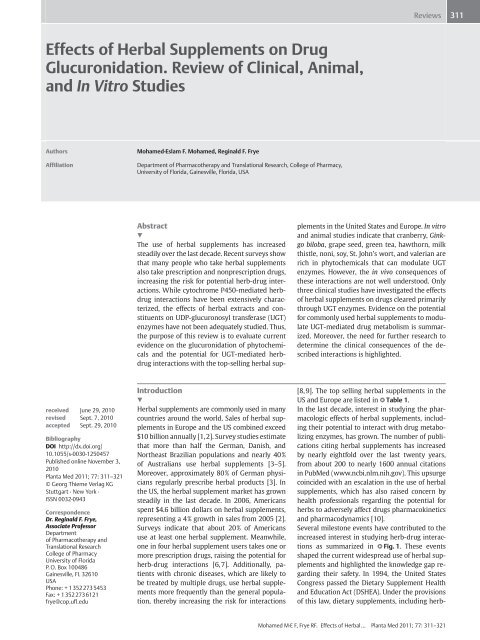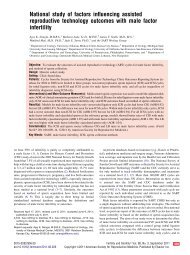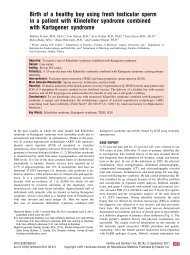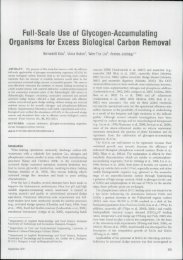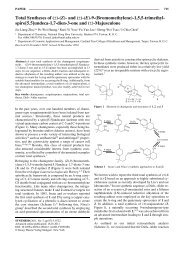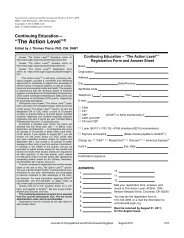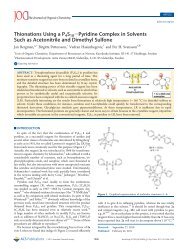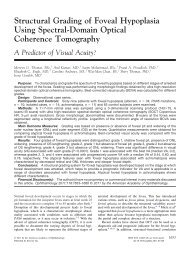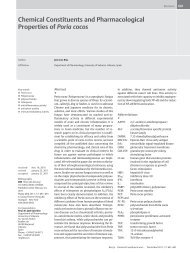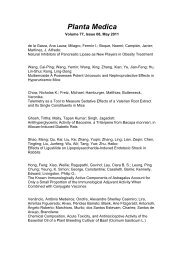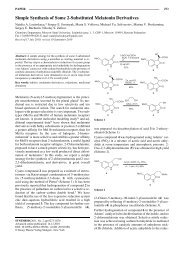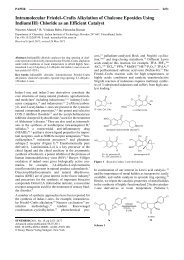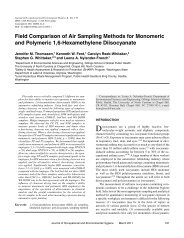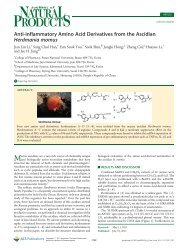Effects of Herbal Supplements on Drug Glucuronidation. Review of ...
Effects of Herbal Supplements on Drug Glucuronidation. Review of ...
Effects of Herbal Supplements on Drug Glucuronidation. Review of ...
You also want an ePaper? Increase the reach of your titles
YUMPU automatically turns print PDFs into web optimized ePapers that Google loves.
<str<strong>on</strong>g>Effects</str<strong>on</strong>g> <str<strong>on</strong>g>of</str<strong>on</strong>g> <str<strong>on</strong>g>Herbal</str<strong>on</strong>g> <str<strong>on</strong>g>Supplements</str<strong>on</strong>g> <strong>on</strong> <strong>Drug</strong><br />
Glucur<strong>on</strong>idati<strong>on</strong>. <strong>Review</strong> <str<strong>on</strong>g>of</str<strong>on</strong>g> Clinical, Animal,<br />
and In Vitro Studies<br />
Authors Mohamed-Eslam F. Mohamed, Reginald F. Frye<br />
Affiliati<strong>on</strong> Department <str<strong>on</strong>g>of</str<strong>on</strong>g> Pharmacotherapy and Translati<strong>on</strong>al Research, College <str<strong>on</strong>g>of</str<strong>on</strong>g> Pharmacy,<br />
University <str<strong>on</strong>g>of</str<strong>on</strong>g> Florida, Gainesville, Florida, USA<br />
received June 29, 2010<br />
revised Sept. 7, 2010<br />
accepted Sept. 29, 2010<br />
Bibliography<br />
DOI http://dx.doi.org/<br />
10.1055/s-0030-1250457<br />
Published <strong>on</strong>line November 3,<br />
2010<br />
Planta Med 2011; 77: 311–321<br />
© Georg Thieme Verlag KG<br />
Stuttgart · New York ·<br />
ISSN 0032‑0943<br />
Corresp<strong>on</strong>dence<br />
Dr. Reginald F. Frye,<br />
Associate Pr<str<strong>on</strong>g>of</str<strong>on</strong>g>essor<br />
Department<br />
<str<strong>on</strong>g>of</str<strong>on</strong>g> Pharmacotherapy and<br />
Translati<strong>on</strong>al Research<br />
College <str<strong>on</strong>g>of</str<strong>on</strong>g> Pharmacy<br />
University <str<strong>on</strong>g>of</str<strong>on</strong>g> Florida<br />
P. O. Box 100486<br />
Gainesville, FL 32610<br />
USA<br />
Ph<strong>on</strong>e: + 13522735453<br />
Fax: + 13522736121<br />
frye@cop.ufl.edu<br />
Abstract<br />
!<br />
The use <str<strong>on</strong>g>of</str<strong>on</strong>g> herbal supplements has increased<br />
steadily over the last decade. Recent surveys show<br />
that many people who take herbal supplements<br />
also take prescripti<strong>on</strong> and n<strong>on</strong>prescripti<strong>on</strong> drugs,<br />
increasing the risk for potential herb-drug interacti<strong>on</strong>s.<br />
While cytochrome P450-mediated herbdrug<br />
interacti<strong>on</strong>s have been extensively characterized,<br />
the effects <str<strong>on</strong>g>of</str<strong>on</strong>g> herbal extracts and c<strong>on</strong>stituents<br />
<strong>on</strong> UDP-glucur<strong>on</strong>osyl transferase (UGT)<br />
enzymes have not been adequately studied. Thus,<br />
the purpose <str<strong>on</strong>g>of</str<strong>on</strong>g> this review is to evaluate current<br />
evidence <strong>on</strong> the glucur<strong>on</strong>idati<strong>on</strong> <str<strong>on</strong>g>of</str<strong>on</strong>g> phytochemicals<br />
and the potential for UGT-mediated herbdrug<br />
interacti<strong>on</strong>s with the top-selling herbal sup-<br />
Introducti<strong>on</strong><br />
!<br />
<str<strong>on</strong>g>Herbal</str<strong>on</strong>g> supplements are comm<strong>on</strong>ly used in many<br />
countries around the world. Sales <str<strong>on</strong>g>of</str<strong>on</strong>g> herbal supplements<br />
in Europe and the US combined exceed<br />
$10 billi<strong>on</strong> annually [1, 2]. Survey studies estimate<br />
that more than half the German, Danish, and<br />
Northeast Brazilian populati<strong>on</strong>s and nearly 40%<br />
<str<strong>on</strong>g>of</str<strong>on</strong>g> Australians use herbal supplements [3–5].<br />
Moreover, approximately 80% <str<strong>on</strong>g>of</str<strong>on</strong>g> German physicians<br />
regularly prescribe herbal products [3]. In<br />
the US, the herbal supplement market has grown<br />
steadily in the last decade. In 2006, Americans<br />
spent $4.6 billi<strong>on</strong> dollars <strong>on</strong> herbal supplements,<br />
representing a 4% growth in sales from 2005 [2].<br />
Surveys indicate that about 20% <str<strong>on</strong>g>of</str<strong>on</strong>g> Americans<br />
use at least <strong>on</strong>e herbal supplement. Meanwhile,<br />
<strong>on</strong>e in four herbal supplement users takes <strong>on</strong>e or<br />
more prescripti<strong>on</strong> drugs, raising the potential for<br />
herb-drug interacti<strong>on</strong>s [6,7]. Additi<strong>on</strong>ally, patients<br />
with chr<strong>on</strong>ic diseases, which are likely to<br />
be treated by multiple drugs, use herbal supplements<br />
more frequently than the general populati<strong>on</strong>,<br />
thereby increasing the risk for interacti<strong>on</strong>s<br />
<strong>Review</strong>s<br />
plements in the United States and Europe. In vitro<br />
and animal studies indicate that cranberry, Ginkgo<br />
biloba, grape seed, green tea, hawthorn, milk<br />
thistle, n<strong>on</strong>i, soy, St. Johnʼs wort, and valerian are<br />
rich in phytochemicals that can modulate UGT<br />
enzymes. However, the in vivo c<strong>on</strong>sequences <str<strong>on</strong>g>of</str<strong>on</strong>g><br />
these interacti<strong>on</strong>s are not well understood. Only<br />
three clinical studies have investigated the effects<br />
<str<strong>on</strong>g>of</str<strong>on</strong>g> herbal supplements <strong>on</strong> drugs cleared primarily<br />
through UGT enzymes. Evidence <strong>on</strong> the potential<br />
for comm<strong>on</strong>ly used herbal supplements to modulate<br />
UGT-mediated drug metabolism is summarized.<br />
Moreover, the need for further research to<br />
determine the clinical c<strong>on</strong>sequences <str<strong>on</strong>g>of</str<strong>on</strong>g> the described<br />
interacti<strong>on</strong>s is highlighted.<br />
[8, 9]. The top selling herbal supplements in the<br />
US and Europe are listed in l " Table 1.<br />
In the last decade, interest in studying the pharmacologic<br />
effects <str<strong>on</strong>g>of</str<strong>on</strong>g> herbal supplements, including<br />
their potential to interact with drug metabolizing<br />
enzymes, has grown. The number <str<strong>on</strong>g>of</str<strong>on</strong>g> publicati<strong>on</strong>s<br />
citing herbal supplements has increased<br />
by nearly eightfold over the last twenty years,<br />
from about 200 to nearly 1600 annual citati<strong>on</strong>s<br />
in PubMed (www.ncbi.nlm.nih.gov). This upsurge<br />
coincided with an escalati<strong>on</strong> in the use <str<strong>on</strong>g>of</str<strong>on</strong>g> herbal<br />
supplements, which has also raised c<strong>on</strong>cern by<br />
health pr<str<strong>on</strong>g>of</str<strong>on</strong>g>essi<strong>on</strong>als regarding the potential for<br />
herbs to adversely affect drugs pharmacokinetics<br />
and pharmacodynamics [10].<br />
Several milest<strong>on</strong>e events have c<strong>on</strong>tributed to the<br />
increased interest in studying herb-drug interacti<strong>on</strong>s<br />
as summarized in l " Fig. 1. These events<br />
shaped the current widespread use <str<strong>on</strong>g>of</str<strong>on</strong>g> herbal supplements<br />
and highlighted the knowledge gap regarding<br />
their safety. In 1994, the United States<br />
C<strong>on</strong>gress passed the Dietary Supplement Health<br />
and Educati<strong>on</strong> Act (DSHEA). Under the provisi<strong>on</strong>s<br />
<str<strong>on</strong>g>of</str<strong>on</strong>g> this law, dietary supplements, including herb-<br />
Mohamed M-E F, Frye RF. <str<strong>on</strong>g>Effects</str<strong>on</strong>g> <str<strong>on</strong>g>of</str<strong>on</strong>g> <str<strong>on</strong>g>Herbal</str<strong>on</strong>g>… Planta Med 2011; 77: 311–321<br />
311
312<br />
<strong>Review</strong>s<br />
Table 1 Top selling herbal supplements in the United States and Europe.<br />
Source: NBJʼs Supplement Business Report, October 2007 [2] and IMS Health<br />
2009 (http://www.imshealth.com).<br />
US Europe<br />
Top herbs Sales<br />
($ milli<strong>on</strong>s)<br />
Top herbs Sales<br />
1 N<strong>on</strong>i juice 257 Ginkgo biloba 300<br />
2 Garlic 155 Saw palmetto 114<br />
3 Mangosteen juice 147 Valerian 61<br />
4 Green tea 144 English ivy 54<br />
5 Saw<br />
palmetto<br />
134 Pelarg<strong>on</strong>ium<br />
sidoides<br />
6 Echinacea 129 Psyllium 50<br />
7 Ginkgo biloba 106 Diosmin 45<br />
8 Ginseng 98 Grape seed 43<br />
9 Milk thistle 93 Myrtol 43<br />
10 Psyllium 85 Echinacea 40<br />
11 Soy 69 Milk thistle 40<br />
12 Cranberry 68 St. Johnʼs wort 40<br />
13 Maca 66 Sennosides A & B 34<br />
14 Goji 65 Hawthorn 34<br />
15 Green foods 64 Cranberry 33<br />
16 St. Johnʼs wort 60<br />
17 Aloe 60<br />
18 Stevia 58<br />
19 Black cohosh 57<br />
20 Valerian 55<br />
($ milli<strong>on</strong>s)<br />
als, are exempt from regulati<strong>on</strong>s applied to drugs, including premarketing<br />
safety and efficacy studies [11]. C<strong>on</strong>currently, the Internet<br />
became widely accessible and was comm<strong>on</strong>ly used to market<br />
herbal products, which led to an increase in the use <str<strong>on</strong>g>of</str<strong>on</strong>g> herbal<br />
supplements in the mid to late 1990s [12]. In 1998, the C<strong>on</strong>gress<br />
established the Nati<strong>on</strong>al Center for Complementary and Alternative<br />
Medicine (NCCAM) with the goal <str<strong>on</strong>g>of</str<strong>on</strong>g> funding research <strong>on</strong> the<br />
safety and efficacy <str<strong>on</strong>g>of</str<strong>on</strong>g> complementary and alternative medicine,<br />
including herbal supplements (nccam.nih.gov). Two years later,<br />
a milest<strong>on</strong>e case report published in The Lancet described an interacti<strong>on</strong><br />
between St. Johnʼs wort, an herbal supplement comm<strong>on</strong>ly<br />
used for depressi<strong>on</strong>, with the immunosuppressant drug<br />
cyclosporine [13]. This case report sparked a wave <str<strong>on</strong>g>of</str<strong>on</strong>g> clinical, in<br />
vitro, and animal studies addressing St. Johnʼs wort interacti<strong>on</strong>s<br />
Mohamed M-E F, Frye RF. <str<strong>on</strong>g>Effects</str<strong>on</strong>g> <str<strong>on</strong>g>of</str<strong>on</strong>g> <str<strong>on</strong>g>Herbal</str<strong>on</strong>g> … Planta Med 2011; 77: 311–321<br />
52<br />
with drug metabolizing enzymes and transporters [14]. Meanwhile,<br />
reports emerged associating ephedra use with heart attacks;<br />
these reports eventually led to a ban in sales <str<strong>on</strong>g>of</str<strong>on</strong>g> over the<br />
counter ephedra-c<strong>on</strong>taining products in several countries including<br />
the US, Canada, Australia, and Germany (http://www.erowid.<br />
org; accessed May 2010). These events set <str<strong>on</strong>g>of</str<strong>on</strong>g>f an alarm that research<br />
was needed to characterize the safety <str<strong>on</strong>g>of</str<strong>on</strong>g> herbal supplements<br />
as well as their potential to interact with c<strong>on</strong>venti<strong>on</strong>al<br />
drugs.<br />
In general, regulati<strong>on</strong> <str<strong>on</strong>g>of</str<strong>on</strong>g> herbal products is greater in the European<br />
Uni<strong>on</strong> (EU) than in the US. A 2004 EU directive mandates<br />
manufacturers <str<strong>on</strong>g>of</str<strong>on</strong>g> herbal products to register and license their<br />
products by the European Agency prior to marketing. In additi<strong>on</strong>,<br />
it mandates premarketing safety evaluati<strong>on</strong>s as well as postmarketing<br />
surveillance for serious adverse events [1]. In the US, the<br />
scientific community has recently requested that the FDA play a<br />
more rigorous role in evaluating safety and efficacy <str<strong>on</strong>g>of</str<strong>on</strong>g> herbal supplements<br />
with calls for premarketing safety data and studies <strong>on</strong><br />
interacti<strong>on</strong>s with drug metabolizing enzymes [15].<br />
Several case studies, reports, and review articles have described<br />
the potential <str<strong>on</strong>g>of</str<strong>on</strong>g> herbal supplements and phytochemicals to modulate<br />
cytochrome P450 (CYP) enzymes. C<strong>on</strong>versely, the effect <str<strong>on</strong>g>of</str<strong>on</strong>g><br />
herbal extracts <strong>on</strong> glucur<strong>on</strong>idati<strong>on</strong>, a major c<strong>on</strong>jugative metabolism<br />
pathway, has not been sufficiently studied. The aim <str<strong>on</strong>g>of</str<strong>on</strong>g> this<br />
review is to summarize evidence regarding the potential <str<strong>on</strong>g>of</str<strong>on</strong>g> the<br />
top-selling herbal supplements in the US and Europe to interact<br />
with UGT enzymes.<br />
Potential for Herb-<strong>Drug</strong> Interacti<strong>on</strong>s<br />
through <strong>Drug</strong> Metabolizing Enzymes<br />
!<br />
Enzymatic biotransformati<strong>on</strong> (i.e., metabolism) plays a major role<br />
in the dispositi<strong>on</strong> <str<strong>on</strong>g>of</str<strong>on</strong>g> endogenous and exogenous compounds including<br />
both drugs and herbal c<strong>on</strong>stituents. Biotransformati<strong>on</strong><br />
reacti<strong>on</strong>s are generally divided into phase I and phase II reacti<strong>on</strong>s,<br />
each <str<strong>on</strong>g>of</str<strong>on</strong>g> them encompassing a wide range <str<strong>on</strong>g>of</str<strong>on</strong>g> enzymes and<br />
catalytic activities [16]. Phase I reacti<strong>on</strong>s involve hydrolysis, reducti<strong>on</strong>,<br />
and oxidati<strong>on</strong> and usually result in <strong>on</strong>ly a small increase<br />
in hydrophilicity [17]. In phase I, CYP enzymes rank first in terms<br />
<str<strong>on</strong>g>of</str<strong>on</strong>g> clinical importance and number <str<strong>on</strong>g>of</str<strong>on</strong>g> substrates. On the other<br />
hand, phase II reacti<strong>on</strong>s include c<strong>on</strong>jugati<strong>on</strong> <str<strong>on</strong>g>of</str<strong>on</strong>g> compounds with<br />
Fig. 1 Timeline for milest<strong>on</strong>e events that have increased<br />
interest in studying herb-drug interacti<strong>on</strong>s.<br />
Abbreviati<strong>on</strong>s: DSHEA, Dietary Supplement Health<br />
and Educati<strong>on</strong> Act; HS, <str<strong>on</strong>g>Herbal</str<strong>on</strong>g> <str<strong>on</strong>g>Supplements</str<strong>on</strong>g>;<br />
NCCAM, the Nati<strong>on</strong>al Center for Complementary<br />
and Alternative Medicine; FDA, the Food and <strong>Drug</strong><br />
Administrati<strong>on</strong>.
a hydrophilic group producing a more hydrophilic and easily excreted<br />
product (except for acetylati<strong>on</strong> and methylati<strong>on</strong>). Phase II<br />
reacti<strong>on</strong>s may or may not be preceded by phase I reacti<strong>on</strong>s. For<br />
some substrates, such as morphine and mycophenolic acid, phase<br />
II c<strong>on</strong>jugati<strong>on</strong> with glucur<strong>on</strong>ic acid represents the primary metabolic<br />
pathway [17].<br />
<str<strong>on</strong>g>Herbal</str<strong>on</strong>g> supplements c<strong>on</strong>tain a myriad <str<strong>on</strong>g>of</str<strong>on</strong>g> natural chemicals that<br />
share the same metabolic pathways with prescripti<strong>on</strong> drugs<br />
[18]. This may result in activati<strong>on</strong> or inhibiti<strong>on</strong> <str<strong>on</strong>g>of</str<strong>on</strong>g> the metabolism<br />
<str<strong>on</strong>g>of</str<strong>on</strong>g> c<strong>on</strong>comitantly taken drugs, under- or overexposure to drugs,<br />
and c<strong>on</strong>sequently, treatment failure or toxicity. At least 30 clinically<br />
proven herb-drug interacti<strong>on</strong>s mediated through CYP enzymes<br />
have been described [19–21]. Inducti<strong>on</strong> <str<strong>on</strong>g>of</str<strong>on</strong>g> CYP2C19, for<br />
example, by Ginkgo biloba resulted in subtherapeutic levels <str<strong>on</strong>g>of</str<strong>on</strong>g><br />
antic<strong>on</strong>vulsant drugs, which precipitated fatal seizures [22].<br />
St. Johnʼs wort has the most documented evidence <str<strong>on</strong>g>of</str<strong>on</strong>g> pharmacokinetic<br />
drug interacti<strong>on</strong>s with more than 100 publicati<strong>on</strong>s in the<br />
last 10 years <strong>on</strong> its interacti<strong>on</strong>s with prescripti<strong>on</strong> drugs [20]. For<br />
example, inducti<strong>on</strong> <str<strong>on</strong>g>of</str<strong>on</strong>g> CYP3A4 and P-glycoprotein by St. Johnʼs<br />
wort resulted in decreased exposure to midazolam (↓ 44%), tacrolimus<br />
(↓ 59%), alprazolam (↓ 52%), verapamil (↓ 80%), and<br />
cyclosporine A (↓ 52%) [23]. In c<strong>on</strong>trast, interacti<strong>on</strong>s through<br />
glucur<strong>on</strong>idati<strong>on</strong> have not been adequately characterized.<br />
Glucur<strong>on</strong>idati<strong>on</strong> enzymes<br />
C<strong>on</strong>jugati<strong>on</strong> with glucur<strong>on</strong>ic acid (glucur<strong>on</strong>idati<strong>on</strong>) represents<br />
the main phase II reacti<strong>on</strong> and <strong>on</strong>e <str<strong>on</strong>g>of</str<strong>on</strong>g> the most essential detoxificati<strong>on</strong><br />
pathways in humans [24]. The UDP-glucur<strong>on</strong>osyl transferases<br />
(UGT) are a superfamily <str<strong>on</strong>g>of</str<strong>on</strong>g> 18 different enzymes divided into<br />
two families, UGT1 and UGT2, and three subfamilies, UGT1A, 2A,<br />
and 2B based <strong>on</strong> sequence homology (l " Fig. 2) [25]. UGT enzymes<br />
are widely and differentially expressed throughout the<br />
human body [26]. Although the majority <str<strong>on</strong>g>of</str<strong>on</strong>g> UGT enzymes are expressed<br />
in the liver, UGT1A7, 1A8, and 1A10 are expressed exclusively<br />
extrahepatically, mainly in the intestine [27, 28]; UGT1A9,<br />
2B7, and 2B11 are expressed at relatively high amounts in the<br />
kidney. l " Fig. 2 depicts the difference in UGT expressi<strong>on</strong> between<br />
the liver and intestine, which are the main sites for xenobiotic<br />
glucur<strong>on</strong>idati<strong>on</strong>.<br />
Glucur<strong>on</strong>idati<strong>on</strong> as a pathway for drug interacti<strong>on</strong>s<br />
Several reports document the clinical significance <str<strong>on</strong>g>of</str<strong>on</strong>g> interacti<strong>on</strong>s<br />
through UGT enzymes. The glucur<strong>on</strong>idati<strong>on</strong> pathway has been<br />
frequently described as a low affinity pathway, with a relatively<br />
small impact <strong>on</strong> substrate exposure in vivo as a result <str<strong>on</strong>g>of</str<strong>on</strong>g> inhibiti<strong>on</strong><br />
[29,30]. This has been observed for substrates that have alternative<br />
metabolic pathways and relatively low affinity for UGT<br />
enzymes. However, if the substrate is metabolized mainly<br />
through glucur<strong>on</strong>idati<strong>on</strong>, inhibiti<strong>on</strong> can result in a significant increase<br />
in exposure. For example, exposure to zidovudine, a substrate<br />
for UGT2B7, increased by 31% and 74% due to inhibiti<strong>on</strong><br />
<str<strong>on</strong>g>of</str<strong>on</strong>g> glucur<strong>on</strong>idati<strong>on</strong> by atovaqu<strong>on</strong>e and fluc<strong>on</strong>azole, respectively<br />
[31, 32]. Moreover, rash, which could be life-threatening, resulted<br />
from inhibiti<strong>on</strong> <str<strong>on</strong>g>of</str<strong>on</strong>g> lamotrigine N-glucur<strong>on</strong>idati<strong>on</strong> by valproic acid<br />
[33]. In additi<strong>on</strong> to inhibiti<strong>on</strong>, interacti<strong>on</strong>s with glucur<strong>on</strong>idati<strong>on</strong><br />
can occur through inducti<strong>on</strong> <str<strong>on</strong>g>of</str<strong>on</strong>g> UGT enzymes. Studies have<br />
reported that rifampicin and lopinavir/rit<strong>on</strong>avir induced lamotrigine<br />
glucur<strong>on</strong>idati<strong>on</strong>, which required a doubling <str<strong>on</strong>g>of</str<strong>on</strong>g> the dose to<br />
maintain a therapeutic plasma c<strong>on</strong>centrati<strong>on</strong> [34,35]. These examples<br />
show that drug-drug interacti<strong>on</strong>s through modulati<strong>on</strong> <str<strong>on</strong>g>of</str<strong>on</strong>g><br />
glucur<strong>on</strong>idati<strong>on</strong> can be clinically significant. Similarly, since<br />
<strong>Review</strong>s<br />
Fig. 2 Expressi<strong>on</strong> <str<strong>on</strong>g>of</str<strong>on</strong>g> UGT enzymes in the liver and the small intestine.<br />
A Relative expressi<strong>on</strong> <str<strong>on</strong>g>of</str<strong>on</strong>g> hepatic UGT enzyme based <strong>on</strong> 20 human liver<br />
samples. Adapted from Izukawa et al. [28]. B Relative expressi<strong>on</strong> <str<strong>on</strong>g>of</str<strong>on</strong>g> UGT<br />
enzymes in the small intestine based <strong>on</strong> 3 human intestine samples.<br />
Adapted from Ohno and Nakajin [27].<br />
many phytochemicals are substrates for UGT enzymes, herb-drug<br />
interacti<strong>on</strong>s may occur through this pathway.<br />
Search strategy<br />
Systematic literature searches were c<strong>on</strong>ducted in MEDLINE<br />
(through PubMed) and Google Scholar databases through March<br />
2010. The search terms used were each <str<strong>on</strong>g>of</str<strong>on</strong>g> the top-selling herbal<br />
supplements in the US and Europe (l " Table 1) or their main sec<strong>on</strong>dary<br />
metabolites in combinati<strong>on</strong> with the terms “glucur<strong>on</strong>idati<strong>on</strong>”<br />
or “UGT”. Only articles written in English were included. No<br />
other restricti<strong>on</strong>s were imposed. When interacti<strong>on</strong>s are reported<br />
from in vitro or animal studies, the possibility <str<strong>on</strong>g>of</str<strong>on</strong>g> an in vivo interacti<strong>on</strong><br />
is discussed based <strong>on</strong> expected in vivo c<strong>on</strong>centrati<strong>on</strong>s <str<strong>on</strong>g>of</str<strong>on</strong>g><br />
phytochemicals, the c<strong>on</strong>diti<strong>on</strong>s used in the experiments, and<br />
the observed inhibiti<strong>on</strong> potency (l " Table 2).<br />
<str<strong>on</strong>g>Herbal</str<strong>on</strong>g> Medicines C<strong>on</strong>taining Substrates<br />
or Modulators <str<strong>on</strong>g>of</str<strong>on</strong>g> UGT Enzymes<br />
!<br />
Aloe<br />
Aloe vera leaf extract is used as an herbal supplement due to its<br />
attributed biological benefits, including antiviral, antibacterial,<br />
laxative, and immunostimulatory effects [36]. It c<strong>on</strong>tains several<br />
classes <str<strong>on</strong>g>of</str<strong>on</strong>g> phytochemicals that have been thoroughly described<br />
[37]. Am<strong>on</strong>g the different classes, Aloe vera extract is rich in anthracene<br />
derivatives including aloe-emodin. There is evidence<br />
that glucur<strong>on</strong>idati<strong>on</strong> is the primary route <str<strong>on</strong>g>of</str<strong>on</strong>g> metabolism <str<strong>on</strong>g>of</str<strong>on</strong>g> aloe-<br />
Mohamed M-E F, Frye RF. <str<strong>on</strong>g>Effects</str<strong>on</strong>g> <str<strong>on</strong>g>of</str<strong>on</strong>g> <str<strong>on</strong>g>Herbal</str<strong>on</strong>g>… Planta Med 2011; 77: 311–321<br />
313
314<br />
<strong>Review</strong>s<br />
Table 2 Summary <str<strong>on</strong>g>of</str<strong>on</strong>g> studies <strong>on</strong> glucur<strong>on</strong>idati<strong>on</strong> <str<strong>on</strong>g>of</str<strong>on</strong>g> phytochemicals and modulati<strong>on</strong> <str<strong>on</strong>g>of</str<strong>on</strong>g> UGT enzymes by phytochemicals and herbal extracts.<br />
Herb Phytochemicals studied<br />
for glucur<strong>on</strong>idati<strong>on</strong><br />
(UGT enzymes involved)<br />
Interacti<strong>on</strong> studies<br />
In vitro Animal Clinical References<br />
Aloe Aloe-emodin (uncharacterized) [38]<br />
Cranberry Quercetin (UGT1A3, UGT1A9) Quercetin:<br />
Quercetin:<br />
[42–46,48, 54,65]<br />
Resveratrol (UGT1A1, UGT1A9) ↑UGT2B17<br />
↓UGT1A1<br />
↓UGT1A9<br />
↑UGT (n<strong>on</strong>specific)<br />
Diosmin Diosmin (uncharacterized) [61,62]<br />
Echinacea Echinacoside (uncharacterized) Echinacea extract:<br />
↓UGT1A1<br />
[64,65]<br />
Garlic ↔ UGT1A6 [67]<br />
Ginkgo biloba* Flav<strong>on</strong>oids (UGT1A3, UGT1A9) Ginkgo extract:<br />
Flav<strong>on</strong>oids:<br />
[42–46,48]<br />
↓UGT1A9<br />
Flav<strong>on</strong>oids:<br />
↑UGT2B17<br />
↓UGT1A1<br />
↓UGT1A9<br />
↑UGT (n<strong>on</strong>specific)<br />
Ginseng ND ↔UGT2B7 [76–78]<br />
Grape seed Flav<strong>on</strong>oids (UGT1A3, UGT1A9) Flav<strong>on</strong>oids:<br />
Flav<strong>on</strong>oids:<br />
[42–46,48, 54,56, 80]<br />
Resveratrol (UGT1A1, UGT1A9) ↑UGT2B17<br />
↑UGT (n<strong>on</strong>specific)<br />
Catechins (uncharacterized) ↓UGT1A1<br />
↓UGT1A9<br />
Green tea* EGCG >> EGC<br />
Polyphenols:<br />
Green tea extract:<br />
[65,84–86]<br />
(UGT1A1, UGT1A8, UGT1A9) ↓UGT1A<br />
EGCG:<br />
↓UGT1A1<br />
↑UGT1A<br />
Hawthorn Quercetin (UGT1A3, UGT1A9) Quercetin:<br />
Quercetin:<br />
[44–46,48, 94]<br />
Epicatechin (uncharacterized) ↑UGT2B17<br />
↓UGT1A1<br />
↓UGT1A9<br />
↑UGT (n<strong>on</strong>specific)<br />
Mangosteen α-Mangostin (uncharacterized) [96]<br />
Milk thistle* Flav<strong>on</strong>olignans (uncharacterized) Milk thistle extract:<br />
↓UGT1A1<br />
Silymarin & silybin:<br />
↓UGT1A1<br />
↓UGT1A6<br />
↓UGT1A9<br />
Silybin:<br />
↓UGT2B7<br />
↓UGT2B15<br />
↔UGT1A1 [44,65, 100–103]<br />
N<strong>on</strong>i juice N<strong>on</strong>i juice:<br />
↓UGT (n<strong>on</strong>specific)<br />
[105]<br />
Soy* Is<str<strong>on</strong>g>of</str<strong>on</strong>g>lav<strong>on</strong>es (genistein and daidzein: Genistein:<br />
↔UGT (n<strong>on</strong>specific) [107–108,110,112]<br />
UGT1A1, UGT1A4, UGT1A6, UGT1A7, ↓UGT1A1<br />
1A9; genistein: UGT1A10)<br />
Daidzein:<br />
↑UGT1A1<br />
Soy extract:<br />
↓UGT2B15<br />
St. Johnʼs wort* Quercetin (UGT1A3, UGT1A9) SJW extract:<br />
SJW extract:<br />
[42–46,48, 115,117]<br />
↓UGT1A1<br />
L<strong>on</strong>g-term: ↓Irinotecan & SN-38<br />
Quercetin:<br />
Cmax<br />
↑UGT2B17<br />
Short-term:<br />
↓UGT1A1<br />
↓SN‑38 glucur<strong>on</strong>ide AUC0–∞ &t1/2 ↓UGT1A9<br />
Hypericin: ↓UGT1A6<br />
Quercetin: ↑UGT (n<strong>on</strong>specific)<br />
Valerian* Valerian & valerenic acid:<br />
↓UGT1A1<br />
↓UGT2B7<br />
↓UGT (n<strong>on</strong>specific)<br />
[121]<br />
* <str<strong>on</strong>g>Effects</str<strong>on</strong>g> <strong>on</strong> glucur<strong>on</strong>idati<strong>on</strong> by these herbal extracts could potentially translate in vivo – further studies are warranted. Uncharacterized: there is evidence that the phytochem-<br />
icals are glucur<strong>on</strong>idated; however, the UGT enzymes involved have not been characterized. ND: Metabolism <str<strong>on</strong>g>of</str<strong>on</strong>g> the herb or its phytochemical was studied, but no glucur<strong>on</strong>ides<br />
detected. ↓, inhibiti<strong>on</strong> <str<strong>on</strong>g>of</str<strong>on</strong>g> UGT; ↑, activati<strong>on</strong> or inducti<strong>on</strong>; ↔, no effect <strong>on</strong> UGT activity<br />
Mohamed M-E F, Frye RF. <str<strong>on</strong>g>Effects</str<strong>on</strong>g> <str<strong>on</strong>g>of</str<strong>on</strong>g> <str<strong>on</strong>g>Herbal</str<strong>on</strong>g> … Planta Med 2011; 77: 311–321
emodin in rats [38]. In vitro characterizati<strong>on</strong> <str<strong>on</strong>g>of</str<strong>on</strong>g> aloe-emodin glucur<strong>on</strong>idati<strong>on</strong><br />
has not been performed.<br />
Cranberry<br />
Cranberry (Vaccinium macrocarp<strong>on</strong>) is <str<strong>on</strong>g>of</str<strong>on</strong>g>ten used to prevent urinary<br />
tract infecti<strong>on</strong>s and has potential antibacterial and anticancer<br />
activity [39]. Cranberry juice has a high c<strong>on</strong>tent <str<strong>on</strong>g>of</str<strong>on</strong>g> flav<strong>on</strong>oids,<br />
catechins, and other phenolic compounds. Although no<br />
studies investigated the effects <str<strong>on</strong>g>of</str<strong>on</strong>g> cranberry juice <strong>on</strong> UGT enzyme<br />
activities, some informati<strong>on</strong> is available <strong>on</strong> the effects <str<strong>on</strong>g>of</str<strong>on</strong>g> quercetin<br />
– the most abundant flav<strong>on</strong>oid in cranberry [39].<br />
Quercetin c<strong>on</strong>tent in cranberry is estimated to be between 83<br />
and 121 mg/kg (about 50 µg in a 500 mg cranberry supplement<br />
capsule) [40]. Quercetin is c<strong>on</strong>jugated by UGT1A9 and, to a lesser<br />
extent, UGT1A3 [41–43]. Studies <strong>on</strong> the activity <str<strong>on</strong>g>of</str<strong>on</strong>g> quercetin <strong>on</strong><br />
UGT enzymes show mixed effects. In two independent studies<br />
using human liver microsomes (HLM), quercetin inhibited<br />
UGT1A1 (IC50 value > 50 µM) and UGT1A9 activities (IC50 value<br />
= 19.1 µM) [44,45]. On the other hand, treatment with 5 µM<br />
quercetin increased testoster<strong>on</strong>e glucur<strong>on</strong>idati<strong>on</strong> (primarily catalyzed<br />
by UGT2B17) by almost 2.5-fold in a prostate cancer cell<br />
line [45–47]. In additi<strong>on</strong>, a study in rats showed that 2-week intake<br />
<str<strong>on</strong>g>of</str<strong>on</strong>g> quercetin (1% w/w in diet) induced p-nitrophenol glucur<strong>on</strong>idati<strong>on</strong><br />
by 1.5- to 4-fold in rat liver and different parts <str<strong>on</strong>g>of</str<strong>on</strong>g> the<br />
intestine [48]. p-Nitrophenol is a n<strong>on</strong>selective UGT substrate;<br />
therefore, it is notclear which UGT enzymes were induced by quercetin<br />
and whether this effect may translate to humans [49–51].<br />
In vivo c<strong>on</strong>centrati<strong>on</strong>s <str<strong>on</strong>g>of</str<strong>on</strong>g> quercetin following cranberry intake are<br />
unlikely to reach inhibitory levels. A pharmacokinetic study<br />
showed that the maximum plasma c<strong>on</strong>centrati<strong>on</strong> (Cmax) <str<strong>on</strong>g>of</str<strong>on</strong>g>quercetin<br />
aglyc<strong>on</strong>e was 15.4 ng/mL (equivalent to 51 nM) following<br />
oral intake <str<strong>on</strong>g>of</str<strong>on</strong>g> 500 mg quercetin [52]. Taking into account the relatively<br />
low c<strong>on</strong>tent <str<strong>on</strong>g>of</str<strong>on</strong>g> quercetin in cranberry supplements (about<br />
50 µg in a 500 mg capsule), in vivo c<strong>on</strong>centrati<strong>on</strong>s <str<strong>on</strong>g>of</str<strong>on</strong>g> quercetin<br />
from cranberry are not expected to be close to the reported IC50<br />
values [44,45].<br />
In additi<strong>on</strong> to flav<strong>on</strong>oids, cranberry juice c<strong>on</strong>tains resveratrol,<br />
which is also found in grapes and red wine [45, 53]. In vitro studies<br />
show that resveratrol is glucur<strong>on</strong>idated to two major glucur<strong>on</strong>ide<br />
c<strong>on</strong>jugates, resveratrol-3′-glucur<strong>on</strong>ide and resveratrol-4′glucur<strong>on</strong>ide.<br />
The major enzymes that catalyze resveratrol glucur<strong>on</strong>idati<strong>on</strong><br />
are UGT1A1 and UGT1A9 [54–56]. No studies <strong>on</strong> the<br />
effects <str<strong>on</strong>g>of</str<strong>on</strong>g> resveratrol <strong>on</strong> UGT enzyme activities were found.<br />
Diosmin<br />
This glycosylated flav<strong>on</strong>oid is found in citrus, hyssop, and rosemary<br />
and is comm<strong>on</strong>ly used for its venot<strong>on</strong>ic effects [57–59]. In<br />
Europe, it is prescribed for treatment <str<strong>on</strong>g>of</str<strong>on</strong>g> venous insufficiency<br />
while in the US, it is marketed as a food supplement [60,61]. A<br />
study in rat liver perfusate showed that diosmin was mainly excreted<br />
in the bile as a glucur<strong>on</strong>ide c<strong>on</strong>jugate [62]. Glucur<strong>on</strong>ides <str<strong>on</strong>g>of</str<strong>on</strong>g><br />
diosmetin (diosmin aglyc<strong>on</strong>e) were detected <strong>on</strong> the apical side <str<strong>on</strong>g>of</str<strong>on</strong>g><br />
Caco-2 cell culture [61]. Specific UGT enzymes associated with<br />
diosmin glucur<strong>on</strong>idati<strong>on</strong> have not been reported. Effect <str<strong>on</strong>g>of</str<strong>on</strong>g> diosmin<br />
<strong>on</strong> drug glucur<strong>on</strong>idati<strong>on</strong> is yet to be determined.<br />
Echinacea<br />
Echinacea products refer to herbs or roots <str<strong>on</strong>g>of</str<strong>on</strong>g> Echinacea purpurea,<br />
Echinacea angustifolia, or Echinacea pallida, or a combinati<strong>on</strong><br />
there<str<strong>on</strong>g>of</str<strong>on</strong>g> [63]. The herbs and roots <str<strong>on</strong>g>of</str<strong>on</strong>g> these different species have<br />
different compositi<strong>on</strong> and medicinal properties. Am<strong>on</strong>g the comm<strong>on</strong><br />
compounds in Echinacea are polyphenolic compounds in-<br />
<strong>Review</strong>s<br />
cluding cichoric acid and echinacoside. Jia et al. studied phase II<br />
metabolites <str<strong>on</strong>g>of</str<strong>on</strong>g> echinacoside in rats and isolated two glucur<strong>on</strong>ide<br />
metabolites for echinacoside [64]. More in vitro studies using<br />
HLM or expressed UGT enzymes are needed to characterize the<br />
relative c<strong>on</strong>tributi<strong>on</strong> <str<strong>on</strong>g>of</str<strong>on</strong>g> individual UGT enzymes to Echinacea<br />
metabolism. We recently showed that Echinacea extract weakly<br />
inhibited UGT1A1 with an IC50 <str<strong>on</strong>g>of</str<strong>on</strong>g> 211.7 µg/mL [65]. Such weak<br />
inhibiti<strong>on</strong> is not expected to have clinical significance <strong>on</strong> the metabolism<br />
<str<strong>on</strong>g>of</str<strong>on</strong>g> UGT1A1 substrates.<br />
Garlic<br />
Garlic (Alium sativum) bulbs have been used for over 4000 years<br />
as a medicinal plant to treat a variety <str<strong>on</strong>g>of</str<strong>on</strong>g> ailments including headache,<br />
bites, intestinal worms, and tumors [66]. Garlic is rich in organo-sulphur<br />
compounds such as alliin, and γ-glutamylcysteines,<br />
diallyl sulphide, diallyl disulphide, and others [66]. These compounds<br />
are not known to be substrates for glucur<strong>on</strong>idati<strong>on</strong>. Gwilt<br />
et al. [67] studied the effect <str<strong>on</strong>g>of</str<strong>on</strong>g> garlic <strong>on</strong> acetaminophen metabolism<br />
in healthy subjects. Subjects were given 10 mL garlic extract<br />
daily (equivalent to six to seven cloves <str<strong>on</strong>g>of</str<strong>on</strong>g> garlic) for three m<strong>on</strong>ths.<br />
Garlic c<strong>on</strong>sumpti<strong>on</strong> did not have a significant effect <strong>on</strong> acetaminophen<br />
or acetaminophen glucur<strong>on</strong>ide pharmacokinetic parameters.<br />
Ginkgo<br />
Ginkgo (Ginkgo biloba) leaf extract is comm<strong>on</strong>ly used for its perpetual<br />
benefits <strong>on</strong> memory and circulati<strong>on</strong>. The primary active<br />
c<strong>on</strong>stituents <str<strong>on</strong>g>of</str<strong>on</strong>g> ginkgo are terpene lact<strong>on</strong>es (ginkgolides and bilobalide)<br />
and flav<strong>on</strong>e glycosides, which are hydrolyzed in vivo to<br />
flav<strong>on</strong>e-aglyc<strong>on</strong>es (e.g., quercetin, kaempferol, and isorhamnetin)<br />
[68]. Ginkgo flav<strong>on</strong>oids are substrates for intestinal and hepatic<br />
UGT enzymes, primarily UGT1A9 and, to a lesser extent,<br />
UGT1A3 [41–43].<br />
There is in vitro and animal evidence that ginkgo and its flav<strong>on</strong>oids<br />
modulate UGT enzymes. As menti<strong>on</strong>ed under cranberry,<br />
quercetin showed inhibiti<strong>on</strong> in vitro <str<strong>on</strong>g>of</str<strong>on</strong>g> UGT1A1 and 1A9 in additi<strong>on</strong><br />
to inducti<strong>on</strong> <str<strong>on</strong>g>of</str<strong>on</strong>g> p-nitrophenol glucur<strong>on</strong>idati<strong>on</strong> in rats [44, 45,<br />
48]. In a prostate cell line, both quercetin and kaempferol induced<br />
testoster<strong>on</strong>e glucur<strong>on</strong>idati<strong>on</strong> in vitro by 2.5- and 4-fold, respectively<br />
[46]. Testoster<strong>on</strong>e is metabolized primarily by UGT2B17,<br />
which plays an important role in androgen metabolism but not<br />
in drug metabolism [69]. We recently showed that unhydrolyzed<br />
and acid-hydrolyzed ginkgo extracts, quercetin, and kaempferol<br />
inhibit mycophenolic acid (MPA) glucur<strong>on</strong>idati<strong>on</strong> in human liver<br />
and intestine microsomes [45]. Inhibiti<strong>on</strong> <str<strong>on</strong>g>of</str<strong>on</strong>g> intestinal glucur<strong>on</strong>idati<strong>on</strong><br />
was 4- to 12-fold more potent than hepatic glucur<strong>on</strong>idati<strong>on</strong>.<br />
MPA is an immunosuppressive drug that is metabolized in<br />
the liver by UGT1A9 and in the intestine by UGT1A7, 1A8, 1A9,<br />
and 1A10 [70–72]. In HLM, IC50 values for inhibiti<strong>on</strong> by quercetin<br />
and kaempferol were 19.1 and 23 µM which are many fold higher<br />
than the expected plasma Cmax <str<strong>on</strong>g>of</str<strong>on</strong>g> flav<strong>on</strong>oids [52]. Therefore, inhibiti<strong>on</strong><br />
<str<strong>on</strong>g>of</str<strong>on</strong>g> systemic MPA metabolism in vivo is unlikely. On the<br />
other hand, IC50 values in human intestine microsome incubati<strong>on</strong>s<br />
were 5.8 µM and 7.6 µM for quercetin and kaempferol, respectively.<br />
These c<strong>on</strong>centrati<strong>on</strong>s are attainable in the intestine<br />
based <strong>on</strong> an estimated intestine fluid volume <str<strong>on</strong>g>of</str<strong>on</strong>g> 0.5 to 5.0 L [73].<br />
Therefore, c<strong>on</strong>comitant intake <str<strong>on</strong>g>of</str<strong>on</strong>g> ginkgo extract with MPA may<br />
result in inhibiti<strong>on</strong> <str<strong>on</strong>g>of</str<strong>on</strong>g> first-pass MPA metabolism, which accounts<br />
for clearance <str<strong>on</strong>g>of</str<strong>on</strong>g> about 30% <str<strong>on</strong>g>of</str<strong>on</strong>g> the dose <str<strong>on</strong>g>of</str<strong>on</strong>g> mycophenolate sodium<br />
[74]. Further clinical studies are warranted to evaluate the clinical<br />
significance <str<strong>on</strong>g>of</str<strong>on</strong>g> this in vivo interacti<strong>on</strong>.<br />
Mohamed M-E F, Frye RF. <str<strong>on</strong>g>Effects</str<strong>on</strong>g> <str<strong>on</strong>g>of</str<strong>on</strong>g> <str<strong>on</strong>g>Herbal</str<strong>on</strong>g>… Planta Med 2011; 77: 311–321<br />
315
316<br />
<strong>Review</strong>s<br />
Ginseng<br />
Ginseng typically refers to roots <str<strong>on</strong>g>of</str<strong>on</strong>g> Panax ginseng or Panax quinquefolium,<br />
which are used as general t<strong>on</strong>ics and adaptogens [75].<br />
The most important bioactive comp<strong>on</strong>ents c<strong>on</strong>tained in ginseng<br />
are a group <str<strong>on</strong>g>of</str<strong>on</strong>g> sap<strong>on</strong>ins called ginsenosides [75]. No reports <str<strong>on</strong>g>of</str<strong>on</strong>g><br />
ginsenosides glucur<strong>on</strong>idati<strong>on</strong> were found in the literature. In a<br />
pharmacokinetic study in which ginsenoside Rd was administered<br />
intravenously to volunteers, no glucur<strong>on</strong>ide c<strong>on</strong>jugates<br />
were detected in plasma [76]. Another in vitro study <strong>on</strong> metabolism<br />
<str<strong>on</strong>g>of</str<strong>on</strong>g> ginsenoside Rg3 using rat S9 liver fracti<strong>on</strong> did not detect<br />
any glucur<strong>on</strong>idated metabolites [77]. In a pharmacokinetic interacti<strong>on</strong><br />
study, 10 healthy volunteers received 300 mg <str<strong>on</strong>g>of</str<strong>on</strong>g> zidovudine,<br />
a UGT2B7 substrate, orally before and after 2 weeks <str<strong>on</strong>g>of</str<strong>on</strong>g> treatment<br />
with 200 mg American ginseng extract twice daily. American<br />
ginseng did not significantly affect the pharmacokinetic parameters<br />
<str<strong>on</strong>g>of</str<strong>on</strong>g> zidovudine or zidovudine glucur<strong>on</strong>ide [78].<br />
Grape seed<br />
Grape seed extract (Vitis vinifera) c<strong>on</strong>tains phenolic and polyphenolic<br />
compounds including flav<strong>on</strong>oids (kaempferol, quercetin,<br />
and myricetin), resveratrol, (+)-catechins, (−)-epicatechin, and<br />
(−)-epicatechin-3-O-gallate [79]. As menti<strong>on</strong>ed, quercetin and<br />
kaempferol are substrates <str<strong>on</strong>g>of</str<strong>on</strong>g> UGT1A3 and UGT1A9 and in vitro<br />
modulators for UGT1A1, UGT1A9, and UGT2B17 [42–46,48].<br />
However, based <strong>on</strong> flav<strong>on</strong>oid c<strong>on</strong>tent in grape seeds <str<strong>on</strong>g>of</str<strong>on</strong>g> 4 to 5%,<br />
in vivo quercetin and kaempferol c<strong>on</strong>centrati<strong>on</strong>s are not likely to<br />
reach inhibitory levels [79]. Resveratrol is also a substrate for<br />
UGT1A1 and UGT1A9 enzymes, but no informati<strong>on</strong> is available<br />
<strong>on</strong> its potential to modulate UGT enzymes [54,55]. In rats, catechin<br />
glucur<strong>on</strong>ides were the primary existing form <str<strong>on</strong>g>of</str<strong>on</strong>g> catechins<br />
in plasma following oral grape seed extract administrati<strong>on</strong> [80].<br />
Taken together, grape seed extract is rich in phytochemicals that<br />
are substrates for UGT enzymes. No studies were found <strong>on</strong> the<br />
potential <str<strong>on</strong>g>of</str<strong>on</strong>g> grape seed extract to modulate UGT-mediated drug<br />
metabolism.<br />
Green tea<br />
Green tea (Camellia sinensis) has gained increased popularity as a<br />
beverage and an herbal supplement with many attributed health<br />
benefits including reducti<strong>on</strong> in the risk <str<strong>on</strong>g>of</str<strong>on</strong>g> cardiovascular disease<br />
and certain cancers [81]. Green tea extract is rich in polyphenolic<br />
compounds – mainly catechins. The major green tea catechins<br />
are: (−)-epigallocatechin-3-gallate (EGCG), (−)-epicatechin-3gallate,<br />
(−)-epigallocatechin (EGC), (−)-epicatechin, (+)-gallocatechin,<br />
and (+)-catechin [82]. EGCG is believed to be the most biologically<br />
active and most abundant catechin in green tea extract<br />
[83]. In vitro, animal, and human studies provide evidence that<br />
green tea catechins are metabolized by methylati<strong>on</strong>, sulfati<strong>on</strong>,<br />
and glucur<strong>on</strong>idati<strong>on</strong> [83]. Lu et al. reported that EGCG was c<strong>on</strong>jugated<br />
by UGT1A1, 1A8, and 1A9 and that glucur<strong>on</strong>idati<strong>on</strong> <str<strong>on</strong>g>of</str<strong>on</strong>g><br />
EGCG was much higher than EGC [84].<br />
In terms <str<strong>on</strong>g>of</str<strong>on</strong>g> interacti<strong>on</strong>s, there is evidence from animal and in vitro<br />
studies that green tea extract modulates UGT enzyme activity.<br />
A study in rats showed that c<strong>on</strong>sumpti<strong>on</strong> <str<strong>on</strong>g>of</str<strong>on</strong>g> green tea extract (at<br />
c<strong>on</strong>centrati<strong>on</strong>s <str<strong>on</strong>g>of</str<strong>on</strong>g> 2.5, 5.0, and 7.5%) for four weeks enhanced hepatic<br />
glucur<strong>on</strong>idati<strong>on</strong> <str<strong>on</strong>g>of</str<strong>on</strong>g> 2-aminophenol [85]. However, the effect<br />
was not dose-dependent and 2-aminophenol is not a selective<br />
substrate for any specific UGT enzyme. So, it is not clear what impact<br />
this effect may have in humans. Zhu et al. investigated the<br />
effect <str<strong>on</strong>g>of</str<strong>on</strong>g> administrati<strong>on</strong> <str<strong>on</strong>g>of</str<strong>on</strong>g> green tea extract for 18 days <strong>on</strong> hepatic<br />
glucur<strong>on</strong>idati<strong>on</strong> activity in female L<strong>on</strong>g-Evans rats. Green tea<br />
extract stimulated liver microsomal glucur<strong>on</strong>idati<strong>on</strong> <str<strong>on</strong>g>of</str<strong>on</strong>g> estr<strong>on</strong>e,<br />
Mohamed M-E F, Frye RF. <str<strong>on</strong>g>Effects</str<strong>on</strong>g> <str<strong>on</strong>g>of</str<strong>on</strong>g> <str<strong>on</strong>g>Herbal</str<strong>on</strong>g> … Planta Med 2011; 77: 311–321<br />
estradiol, and 4-nitrophenol by 30–37%, 15–27%, and 26–60%,<br />
respectively [86]. The same authors reported that green tea polyphenols,<br />
including EGCG, inhibited estradiol and estr<strong>on</strong>e glucur<strong>on</strong>idati<strong>on</strong><br />
in vitro using rat liver microsomes with IC50 values <str<strong>on</strong>g>of</str<strong>on</strong>g><br />
10–20 µg/mL [86]. In agreement with these findings, we recently<br />
showed that EGCG inhibited estradiol-3-O-glucur<strong>on</strong>idati<strong>on</strong>, an<br />
index for UGT1A1 activity, in HLMs [65, 87]. The IC50 value was<br />
7.8 µg/mL, which is similar to the IC50 reported earlier in rat microsomes<br />
[86]. To understand the potential clinical significance <str<strong>on</strong>g>of</str<strong>on</strong>g><br />
this in vitro interacti<strong>on</strong> <strong>on</strong> drugs metabolized by UGT1A1, the reported<br />
IC50 value should be compared to expected in vivo c<strong>on</strong>centrati<strong>on</strong>s<br />
following green tea intake. EGCG Cmax following a<br />
green tea dose c<strong>on</strong>taining 800 mg EGCG was 2.5 µg/mL which is<br />
about threefold lower than the in vitro IC50 [88]. On the other<br />
hand, intestinal c<strong>on</strong>centrati<strong>on</strong>s <str<strong>on</strong>g>of</str<strong>on</strong>g> EGCG are expected to be much<br />
higher than the observed IC50 c<strong>on</strong>centrati<strong>on</strong>s. Therefore, inhibiti<strong>on</strong><br />
<str<strong>on</strong>g>of</str<strong>on</strong>g> first pass metabolism <str<strong>on</strong>g>of</str<strong>on</strong>g> UGT1A1 substrates is more likely<br />
than inhibiti<strong>on</strong> <str<strong>on</strong>g>of</str<strong>on</strong>g> systemic metabolism. Examples <str<strong>on</strong>g>of</str<strong>on</strong>g> drugs<br />
cleared primarily by intestinal first pass UGT1A1 include raloxifene<br />
and ezetimibe [89]. Mirkov et al. investigated the effects <str<strong>on</strong>g>of</str<strong>on</strong>g><br />
green tea catechins <strong>on</strong> the glucur<strong>on</strong>idati<strong>on</strong> <str<strong>on</strong>g>of</str<strong>on</strong>g> SN-38, the active<br />
metabolite <str<strong>on</strong>g>of</str<strong>on</strong>g> the anticancer drug irinotecan, and a UGT1A1 substrate<br />
[90]. In the latter study, green tea catechins inhibited the<br />
glucur<strong>on</strong>idati<strong>on</strong> <str<strong>on</strong>g>of</str<strong>on</strong>g> SN-38 in HLM incubati<strong>on</strong>s in a c<strong>on</strong>centrati<strong>on</strong>-dependent<br />
manner. However, in human hepatocytes, a significant<br />
decrease in SN-38 glucur<strong>on</strong>ide was observed in <strong>on</strong>ly<br />
33% (EGCG), 44% (ECG), and 44% (EGC) <str<strong>on</strong>g>of</str<strong>on</strong>g> the hepatocyte preparati<strong>on</strong>s.<br />
Therefore, the authors c<strong>on</strong>cluded that at pharmacologically<br />
relevant c<strong>on</strong>centrati<strong>on</strong>s, catechins are unlikely to inhibit<br />
the formati<strong>on</strong> <str<strong>on</strong>g>of</str<strong>on</strong>g> inactive irinotecan metabolites when administered<br />
c<strong>on</strong>comitantly [90].<br />
Hawthorn<br />
Hawthorn (Crataegus oxyacantha) extract is used in Europe for its<br />
cardiot<strong>on</strong>ic effects [91]. Hawthorn leaf, flower, and berry extracts<br />
are rich in flav<strong>on</strong>oids and oligomeric catechins that are thought<br />
to be resp<strong>on</strong>sible for pharmacologic activity [91]. Flav<strong>on</strong>oids include<br />
quercetin, isoquercitrin, rutin, hyperoside, and vitexin;<br />
and epicatechin [92, 93]. Quercetin and epicatechin are known<br />
to be substrates for glucur<strong>on</strong>idati<strong>on</strong> [41–43, 83,94]. Quercetin is<br />
an in vitro modulator <str<strong>on</strong>g>of</str<strong>on</strong>g> UGT1A1, 1A9, and 2B17 enzymes as described<br />
above [44–46,48]. No studies were found <strong>on</strong> the effects <str<strong>on</strong>g>of</str<strong>on</strong>g><br />
hawthorn extract <strong>on</strong> UGT enzymes.<br />
Mangosteen juice<br />
Mangosteen (Garcinia mangostana) juice is well-known for its<br />
anti-inflammatory properties and is traditi<strong>on</strong>ally used in the<br />
treatment <str<strong>on</strong>g>of</str<strong>on</strong>g> skin infecti<strong>on</strong>s and wounds [95]. Mangosteen juice<br />
is rich in phenolic compounds called xanth<strong>on</strong>es, mainly α, β, and<br />
γ-mangostin [95]. Bumrungpert et al. showed that α-mangostin<br />
was c<strong>on</strong>jugated by phase II enzymes in caco-2 cells [96]. In their<br />
study, <strong>on</strong>e third <str<strong>on</strong>g>of</str<strong>on</strong>g> α-mangostin was c<strong>on</strong>jugated after 4–6 hours<br />
<str<strong>on</strong>g>of</str<strong>on</strong>g> incubati<strong>on</strong> with cells. C<strong>on</strong>jugati<strong>on</strong> was measured by hydrolysis<br />
using a Helix pomatia-derived enzyme that possesses both glucur<strong>on</strong>idase<br />
and sulfatase activity. Therefore, it was not possible<br />
to determine the relative c<strong>on</strong>tributi<strong>on</strong> <str<strong>on</strong>g>of</str<strong>on</strong>g> glucur<strong>on</strong>idati<strong>on</strong> and<br />
sulfati<strong>on</strong>. No studies were found <strong>on</strong> the effects <str<strong>on</strong>g>of</str<strong>on</strong>g> mangosteen<br />
juice or its phytochemicals <strong>on</strong> drug glucur<strong>on</strong>idati<strong>on</strong>.
Milk thistle<br />
Milk thistle (Silybum marianum) is used to treat hepatotoxicity<br />
[97]. Extract <str<strong>on</strong>g>of</str<strong>on</strong>g> milk thistle is rich in flav<strong>on</strong>olignans, primarily silybin,<br />
silydianin, and silychristine, which are collectively known<br />
as silymarin [98]. There is evidence <strong>on</strong> glucur<strong>on</strong>idati<strong>on</strong> <str<strong>on</strong>g>of</str<strong>on</strong>g> silymarin<br />
flav<strong>on</strong>olignans from both animal and human studies. In a<br />
study in rats, silybin A, silychristin, and silydianin were excreted<br />
as glucur<strong>on</strong>ides [99]. Moreover, silibinin m<strong>on</strong>o- and di-glucur<strong>on</strong>ides<br />
were detected in human plasma following ingesti<strong>on</strong> <str<strong>on</strong>g>of</str<strong>on</strong>g> silibinin<br />
phytosome capsules in colorectal carcinoma patients [100].<br />
In vitro experiments showed inhibitory effects <str<strong>on</strong>g>of</str<strong>on</strong>g> milk thistle<br />
compounds <strong>on</strong> UGT enzymes. In human hepatocytes, silymarin<br />
inhibited glucur<strong>on</strong>idati<strong>on</strong> <str<strong>on</strong>g>of</str<strong>on</strong>g> 4-methylumbellifer<strong>on</strong>e, a substrate<br />
for all UGT1A and 2B enzymes except UGT1A4, by about 80%<br />
and 90% at c<strong>on</strong>centrati<strong>on</strong>s <str<strong>on</strong>g>of</str<strong>on</strong>g> 100 and 250 µM, respectively<br />
[101]. However, the use <str<strong>on</strong>g>of</str<strong>on</strong>g> a n<strong>on</strong>selective substrate and relatively<br />
high c<strong>on</strong>centrati<strong>on</strong>s <str<strong>on</strong>g>of</str<strong>on</strong>g> silymarin limit the clinical utility <str<strong>on</strong>g>of</str<strong>on</strong>g> this<br />
finding. In another study, silybin inhibited recombinant UGT1A1,<br />
1A6, 1A9, 2B7 and 2B15 with IC50 values <str<strong>on</strong>g>of</str<strong>on</strong>g> 1.4, 28, 20, 92, and<br />
75 µM, respectively using 7-hydroxy-4-(trifluoromethyl)coumarin<br />
as a substrate for the different UGT enzymes [102]. In an in<br />
vitro study using HLM and estradiol-3-O-glucur<strong>on</strong>idati<strong>on</strong> as an<br />
index for UGT1A1 activity, silymarin inhibited UGT1A1 at estradiol<br />
c<strong>on</strong>centrati<strong>on</strong>s <str<strong>on</strong>g>of</str<strong>on</strong>g> 50 and 100 µM, while results at lower c<strong>on</strong>centrati<strong>on</strong>s<br />
showed mixed inhibiti<strong>on</strong> and activati<strong>on</strong> [44]. We recently<br />
showed that milk thistle extract inhibited estradiol-3-Oglucur<strong>on</strong>idati<strong>on</strong><br />
in HLM with IC50 value <str<strong>on</strong>g>of</str<strong>on</strong>g> 30.4 µg/mL which is<br />
equivalent to 11.5 µg/mL flav<strong>on</strong>olignans [65].<br />
To understand the potential in vivo effects <str<strong>on</strong>g>of</str<strong>on</strong>g> milk thistle <strong>on</strong> drug<br />
glucur<strong>on</strong>idati<strong>on</strong>, inhibitory c<strong>on</strong>centrati<strong>on</strong>s should be compared<br />
to expected in vivo levels. Cmax <str<strong>on</strong>g>of</str<strong>on</strong>g> total flav<strong>on</strong>olignans was<br />
24 ng/mL following intake <str<strong>on</strong>g>of</str<strong>on</strong>g> 600 mg milk thistle extract. Thus,<br />
plasma c<strong>on</strong>centrati<strong>on</strong>s <str<strong>on</strong>g>of</str<strong>on</strong>g> flav<strong>on</strong>olignans are not expected to<br />
reach IC50 c<strong>on</strong>centrati<strong>on</strong>s reported by our group and others [65,<br />
102]. Therefore, milk thistle intake is not expected to affect systemic<br />
metabolism <str<strong>on</strong>g>of</str<strong>on</strong>g> UGT substrates. In agreement with this c<strong>on</strong>clusi<strong>on</strong>,<br />
4-day and 12-day administrati<strong>on</strong> <str<strong>on</strong>g>of</str<strong>on</strong>g> milk thistle showed<br />
no significant effects <strong>on</strong> the pharmacokinetics <str<strong>on</strong>g>of</str<strong>on</strong>g> the intravenous<br />
anticancer drug irinotecan in cancer patients [103]. In c<strong>on</strong>trast,<br />
intestinal c<strong>on</strong>centrati<strong>on</strong>s <str<strong>on</strong>g>of</str<strong>on</strong>g> milk thistle flav<strong>on</strong>olignans are likely<br />
to be higher than the observed IC50. Based <strong>on</strong> a range <str<strong>on</strong>g>of</str<strong>on</strong>g> intestinal<br />
volume <str<strong>on</strong>g>of</str<strong>on</strong>g> 0.5 to 5.0 L, the expected intestinal c<strong>on</strong>centrati<strong>on</strong> <str<strong>on</strong>g>of</str<strong>on</strong>g><br />
milk thistle extract is 40 to 1200 µg/mL following intake <str<strong>on</strong>g>of</str<strong>on</strong>g> 200<br />
to 600 mg <str<strong>on</strong>g>of</str<strong>on</strong>g> milk thistle [73]. Therefore, further research is warranted<br />
<strong>on</strong> the effect <str<strong>on</strong>g>of</str<strong>on</strong>g> milk thistle <strong>on</strong> drugs cleared primarily by<br />
first pass glucur<strong>on</strong>idati<strong>on</strong> – particularly substrates <str<strong>on</strong>g>of</str<strong>on</strong>g> UGT1A1,<br />
1A6, and 1A9, which showed the lowest IC50 values [65, 102].<br />
N<strong>on</strong>i juice<br />
N<strong>on</strong>i juice (Morinda citrifolia) has a l<strong>on</strong>g history <str<strong>on</strong>g>of</str<strong>on</strong>g> being used for<br />
a wide range <str<strong>on</strong>g>of</str<strong>on</strong>g> indicati<strong>on</strong>s including hypertensi<strong>on</strong>, menstrual<br />
cramps, gastric ulcers, and many others [104]. N<strong>on</strong>i juice c<strong>on</strong>tains<br />
several classes <str<strong>on</strong>g>of</str<strong>on</strong>g> sec<strong>on</strong>dary metabolites, including polysaccharides,<br />
fatty acid glycosides, iridoids, anthraquin<strong>on</strong>es, and flav<strong>on</strong>oids<br />
[104]. Many <str<strong>on</strong>g>of</str<strong>on</strong>g> these are phenolic compounds that could<br />
be substrates for UGT enzymes and may compete with the metabolism<br />
<str<strong>on</strong>g>of</str<strong>on</strong>g> drugs. However, no studies were found regarding<br />
the glucur<strong>on</strong>idati<strong>on</strong> <str<strong>on</strong>g>of</str<strong>on</strong>g> compounds in n<strong>on</strong>i juice. In a study in rats,<br />
n<strong>on</strong>i juice inhibited ex vivo p-nitrophenol glucur<strong>on</strong>idati<strong>on</strong> by<br />
39% at a dose <str<strong>on</strong>g>of</str<strong>on</strong>g> 21 mg/kg following 1 day <str<strong>on</strong>g>of</str<strong>on</strong>g> treatment and by<br />
35% and 49% after 14 days <str<strong>on</strong>g>of</str<strong>on</strong>g> treatment at doses <str<strong>on</strong>g>of</str<strong>on</strong>g> 2.1 and<br />
21 mg/kg, respectively. However, there was no inhibiti<strong>on</strong> at a<br />
<strong>Review</strong>s<br />
higher dose <str<strong>on</strong>g>of</str<strong>on</strong>g> 210 mg/kg [105]. Further research is warranted to<br />
investigate the potential <str<strong>on</strong>g>of</str<strong>on</strong>g> n<strong>on</strong>i juice to alter drug metabolism in<br />
humans.<br />
Soy<br />
There has been increasing interest in soy is<str<strong>on</strong>g>of</str<strong>on</strong>g>lav<strong>on</strong>es, especially<br />
genistein and daidzein, due to their wide range <str<strong>on</strong>g>of</str<strong>on</strong>g> potential biological<br />
activities [106]. In vitro and clinical studies provide evidence<br />
that soy is<str<strong>on</strong>g>of</str<strong>on</strong>g>lav<strong>on</strong>es are substrates for UGT enzymes. Despite<br />
being structurally similar, genistein and daidzein c<strong>on</strong>jugates<br />
exhibit preferences for different UGT enzymes. UGT1A1,<br />
1A4, 1A6, 1A7, and 1A9 catalyzed 7- and 4′-glucur<strong>on</strong>idati<strong>on</strong> <str<strong>on</strong>g>of</str<strong>on</strong>g><br />
both genistein and daidzein, while UGT1A10 was selective for<br />
genistein. The authors also reported that genistein, but not daidzein,<br />
was c<strong>on</strong>jugated in human col<strong>on</strong> microsomes [107]. The glucur<strong>on</strong>ide<br />
was the predominant circulating form for both genistein<br />
(69–98%) and daidzein (40–62%), with smaller amounts <str<strong>on</strong>g>of</str<strong>on</strong>g><br />
the aglyc<strong>on</strong>e and sulfate. This indicates that glucur<strong>on</strong>idati<strong>on</strong> is<br />
the primary route <str<strong>on</strong>g>of</str<strong>on</strong>g> metabolism for these soy is<str<strong>on</strong>g>of</str<strong>on</strong>g>lav<strong>on</strong>es.<br />
Pfeiffer et al. reported that daidzein and genistein as well as several<br />
structurally related is<str<strong>on</strong>g>of</str<strong>on</strong>g>lav<strong>on</strong>es modulated UGT1A1 activity<br />
in vitro using HLM [108]. Daidzein (25 µM) stimulated estradiol-<br />
3-O-glucur<strong>on</strong>idati<strong>on</strong>, a marker for UGT1A1 activity, by about<br />
50%; however, inhibiti<strong>on</strong> was observed at higher daidzein c<strong>on</strong>centrati<strong>on</strong>s<br />
[87]. In c<strong>on</strong>trast, genistein (25 µM) inhibited the 3-<br />
O-glucur<strong>on</strong>idati<strong>on</strong> by about 80%. The 17-glucur<strong>on</strong>idati<strong>on</strong> <str<strong>on</strong>g>of</str<strong>on</strong>g> E2 –<br />
which is catalyzed by several UGT enzymes – was not affected by<br />
either compound. The observed modulatory effects <strong>on</strong> estradiol<br />
metabolism generated interest in the anticancer properties <str<strong>on</strong>g>of</str<strong>on</strong>g><br />
soy is<str<strong>on</strong>g>of</str<strong>on</strong>g>lav<strong>on</strong>es [108, 109]. However, implicati<strong>on</strong>s <str<strong>on</strong>g>of</str<strong>on</strong>g> these effects<br />
<strong>on</strong> the metabolism <str<strong>on</strong>g>of</str<strong>on</strong>g> UGT1A1 drug substrates have not been explored.<br />
The potency <str<strong>on</strong>g>of</str<strong>on</strong>g> estradiol-3-O-glcuru<strong>on</strong>idati<strong>on</strong> inhibiti<strong>on</strong><br />
by genistein was higher than the activati<strong>on</strong> by daidzein. Thus, it<br />
would be expected that the net effect <str<strong>on</strong>g>of</str<strong>on</strong>g> soy extract <strong>on</strong> UGT1A1<br />
activity will be inhibiti<strong>on</strong>. An earlier study by Anders<strong>on</strong> et al.<br />
showed that soy extract was a weak inhibitor <str<strong>on</strong>g>of</str<strong>on</strong>g> estradiol glucur<strong>on</strong>idati<strong>on</strong><br />
(IC50 > 100 µg/mL) [110]. However, it is important to<br />
note that the authors investigated the effect <str<strong>on</strong>g>of</str<strong>on</strong>g> soy extract <strong>on</strong> formati<strong>on</strong><br />
<str<strong>on</strong>g>of</str<strong>on</strong>g> all estradiol glucur<strong>on</strong>ides, which is not a selective measure<br />
for UGT1A1 activity. Therefore, further studies are warranted<br />
to determine the effect <str<strong>on</strong>g>of</str<strong>on</strong>g> soy is<str<strong>on</strong>g>of</str<strong>on</strong>g>lav<strong>on</strong>es <strong>on</strong> the metabolism<br />
<str<strong>on</strong>g>of</str<strong>on</strong>g> UGT1A1 drug substrates. Since soy is being studied for use<br />
in cancer patients, its effects <strong>on</strong> metabolism <str<strong>on</strong>g>of</str<strong>on</strong>g> anticancer drugs<br />
like irinotecan is especially important. In the latter study by Anders<strong>on</strong><br />
et al., unhydrolyzed and hydrolyzed soy extracts inhibited<br />
dihydrotestoster<strong>on</strong>e glucur<strong>on</strong>idati<strong>on</strong>, an index for UGT2B17 activity,<br />
with IC50 values for soy is<str<strong>on</strong>g>of</str<strong>on</strong>g>lav<strong>on</strong>es <str<strong>on</strong>g>of</str<strong>on</strong>g> 4.6 and 6.1 µg/mL,<br />
respectively [47,110]. Although these c<strong>on</strong>centrati<strong>on</strong>s are close<br />
to reported in vivo c<strong>on</strong>centrati<strong>on</strong>s <str<strong>on</strong>g>of</str<strong>on</strong>g> genistein (16.3 µM; equivalent<br />
to 4.4 µg/mL), UGT2B17 is not known to play an important<br />
role in drug metabolism [69, 111].<br />
In a study in mice, genistein and daidzein <strong>on</strong>ly slightly decreased<br />
UGT activities in some tissues in a sex- and durati<strong>on</strong>-dependent<br />
manner [112]. In this study, genistein and daidzein inhibited glucur<strong>on</strong>idati<strong>on</strong><br />
<str<strong>on</strong>g>of</str<strong>on</strong>g> 3-methyl-2-nitrophenol in the small intestine <str<strong>on</strong>g>of</str<strong>on</strong>g><br />
male mice after five days <str<strong>on</strong>g>of</str<strong>on</strong>g> is<str<strong>on</strong>g>of</str<strong>on</strong>g>lav<strong>on</strong>e administrati<strong>on</strong> by about<br />
50% and 40%, respectively. This effect was not reproducible in<br />
the liver and the kidneys, or in female mice. Glucur<strong>on</strong>idati<strong>on</strong> <str<strong>on</strong>g>of</str<strong>on</strong>g><br />
the substrate used in the study (3-methyl-2-nitrophenol) has<br />
not been characterized; therefore, the clinical applicability <str<strong>on</strong>g>of</str<strong>on</strong>g> this<br />
informati<strong>on</strong> is limited.<br />
Mohamed M-E F, Frye RF. <str<strong>on</strong>g>Effects</str<strong>on</strong>g> <str<strong>on</strong>g>of</str<strong>on</strong>g> <str<strong>on</strong>g>Herbal</str<strong>on</strong>g>… Planta Med 2011; 77: 311–321<br />
317
318<br />
<strong>Review</strong>s<br />
St. Johnʼswort<br />
St. Johnʼswort(Hypericum perforatum) extract is used for insomnia<br />
and depressi<strong>on</strong> [113]. Flav<strong>on</strong>ol glycosides are the major class<br />
<str<strong>on</strong>g>of</str<strong>on</strong>g> compounds found in St. Johnʼs wort extract, with rutin, hyperoside,<br />
isoquercitrin, quercitrin (quercetin 3-rhamnoside),<br />
and miquelianin being the main compounds. Other comp<strong>on</strong>ents<br />
include hypericin, pseudohypericin, and hyperforin [114]. As explained<br />
above, quercetin is a known substrate and modulator <str<strong>on</strong>g>of</str<strong>on</strong>g><br />
UGT1A enzymes [42–46,48]. No studies regarding glucur<strong>on</strong>idati<strong>on</strong><br />
<str<strong>on</strong>g>of</str<strong>on</strong>g> other St. Johnʼs wort comp<strong>on</strong>ents were found.<br />
In vitro and animal studies show that St. Johnʼs wort could modulate<br />
UGT enzyme activity. In a recent study, Volak reported that<br />
hypericin inhibited UGT1A6-mediated glucur<strong>on</strong>idati<strong>on</strong> <str<strong>on</strong>g>of</str<strong>on</strong>g> acetaminophen<br />
in human col<strong>on</strong> cells and serot<strong>on</strong>in in UGT1A6-expressing<br />
insect cells with IC50 values <str<strong>on</strong>g>of</str<strong>on</strong>g> 7.1 and 0.59 µM, respectively<br />
(equivalent to 13.6 µg/mL and 0.3 µg/mL, respectively)<br />
[115]. The authors c<strong>on</strong>cluded that the mechanism <str<strong>on</strong>g>of</str<strong>on</strong>g> this interacti<strong>on</strong><br />
was through inhibiti<strong>on</strong> <str<strong>on</strong>g>of</str<strong>on</strong>g> UGT1A6 phosphorylati<strong>on</strong> by<br />
protein kinase C, which is c<strong>on</strong>sidered a novel mechanism <str<strong>on</strong>g>of</str<strong>on</strong>g><br />
drug-drug interacti<strong>on</strong>. The observed IC50 values are much higher<br />
than the reported plasma Cmax <str<strong>on</strong>g>of</str<strong>on</strong>g> hypericin following oral intake<br />
<str<strong>on</strong>g>of</str<strong>on</strong>g> 900 mg St. Johnʼs wort extract (Cmax = 3.8 ng/mL) [116]. Therefore,<br />
the translati<strong>on</strong> <str<strong>on</strong>g>of</str<strong>on</strong>g> this observati<strong>on</strong> into a clinical in vivo<br />
interacti<strong>on</strong> is unlikely.<br />
In an animal study, the effects <str<strong>on</strong>g>of</str<strong>on</strong>g> St. Johnʼs wort <strong>on</strong> irinotecan<br />
pharmacokinetics were measured after 3 and 14 days <str<strong>on</strong>g>of</str<strong>on</strong>g> daily<br />
St. Johnʼs wort administrati<strong>on</strong> [117]. L<strong>on</strong>g-term (14-day) exposure<br />
to St. Johnʼs wort significantly decreased Cmax <str<strong>on</strong>g>of</str<strong>on</strong>g> irinotecan<br />
by 39.5% and SN-38 by 38.9%, but did not significantly affect SN-<br />
38 glucur<strong>on</strong>ide plasma c<strong>on</strong>centrati<strong>on</strong>s. On the other hand, shortterm<br />
(3-day) administrati<strong>on</strong> <str<strong>on</strong>g>of</str<strong>on</strong>g> St. Johnʼs wort did not significantly<br />
alter the pharmacokinetics <str<strong>on</strong>g>of</str<strong>on</strong>g> irinotecan and SN-38, but<br />
decreased the AUC0-∞ and the eliminati<strong>on</strong> t1/2 <str<strong>on</strong>g>of</str<strong>on</strong>g> SN-38 glucur<strong>on</strong>ide<br />
by 31.2% and 25.8%, respectively [117]. In the same study,<br />
St. Johnʼs wort extract (5 µg/mL) decreased SN-38 glucur<strong>on</strong>idati<strong>on</strong><br />
by 45% in rat liver microsomes, while preincubati<strong>on</strong> <str<strong>on</strong>g>of</str<strong>on</strong>g><br />
St. Johnʼs wort extract in hepatoma cells significantly increased<br />
SN-38 glucur<strong>on</strong>idati<strong>on</strong>. Although rat UGT enzymes differ from<br />
human enzymes in substrate affinity, these results indicate that<br />
St. Johnʼs wort may affect pharmacokinetics <str<strong>on</strong>g>of</str<strong>on</strong>g> SN-38 in humans<br />
[118, 119]. This may lead to increased exposure to irinotecan and<br />
SN-38 and, c<strong>on</strong>sequently, increased risk <str<strong>on</strong>g>of</str<strong>on</strong>g> adverse reacti<strong>on</strong>s including<br />
neutropenia and thrombocytopenia.<br />
Valerian<br />
Valerian (Valeriana <str<strong>on</strong>g>of</str<strong>on</strong>g>ficinalis) extract is used to treat sleeping<br />
disorders, restlessness, and anxiety [120]. Alkaloids, organic<br />
acids, terpenes, and valepotriates are am<strong>on</strong>g the major classes<br />
<str<strong>on</strong>g>of</str<strong>on</strong>g> phytochemicals found in valerian extract. In terms <str<strong>on</strong>g>of</str<strong>on</strong>g> interacti<strong>on</strong>s<br />
with UGT enzymes, valerian methanolic extract inhibited<br />
UGT1A1 and UGT2B7 in HLM using estradiol and morphine as<br />
probe substrates, respectively. In the same study, valerenic acid,<br />
a m<strong>on</strong>oterpene in valerian extract, inhibited glucur<strong>on</strong>idati<strong>on</strong> <str<strong>on</strong>g>of</str<strong>on</strong>g><br />
acetaminophen, estradiol, and morphine with both HLM and<br />
expressed UGT enzymes [121]. IC50 values for inhibiti<strong>on</strong> with<br />
valerenic acid were 9.24 µM for acetaminophen glucur<strong>on</strong>idati<strong>on</strong>,<br />
8.79 µM for estradiol-3-O-glucur<strong>on</strong>idati<strong>on</strong>, 2.33 µM for estradiol-<br />
17-O-glucur<strong>on</strong>idati<strong>on</strong>, 4.96 µM for morphine-3-glucur<strong>on</strong>idati<strong>on</strong>,<br />
and 47.31 µM for testoster<strong>on</strong>e glucur<strong>on</strong>idati<strong>on</strong>. All the observed<br />
IC50 values were higher than the reported Cmax following a single<br />
dose <str<strong>on</strong>g>of</str<strong>on</strong>g> valerian <str<strong>on</strong>g>of</str<strong>on</strong>g> 600 mg (Cmax = 2.3 ng/mL) [122]. Based <strong>on</strong> intestinal<br />
fluid volume <str<strong>on</strong>g>of</str<strong>on</strong>g> 0.5 to 5.0 L, valerenic acid c<strong>on</strong>centrati<strong>on</strong>s<br />
Mohamed M-E F, Frye RF. <str<strong>on</strong>g>Effects</str<strong>on</strong>g> <str<strong>on</strong>g>of</str<strong>on</strong>g> <str<strong>on</strong>g>Herbal</str<strong>on</strong>g> … Planta Med 2011; 77: 311–321<br />
in the intestine could fall between 0.8 to 16 µg/mL following intake<br />
<str<strong>on</strong>g>of</str<strong>on</strong>g> 500 to 1000 mg <str<strong>on</strong>g>of</str<strong>on</strong>g> valerian extract. Thus, IC50-equivalent<br />
c<strong>on</strong>centrati<strong>on</strong>s are more likely to be attained in the intestine<br />
rather than the blood following valerian intake. Therefore, the effects<br />
<str<strong>on</strong>g>of</str<strong>on</strong>g> valerian extract <strong>on</strong> intestinal glucur<strong>on</strong>idati<strong>on</strong> warrant<br />
further studies.<br />
C<strong>on</strong>clusi<strong>on</strong> and Summary<br />
!<br />
The studies reviewed provide evidence <strong>on</strong> the potential for modulati<strong>on</strong><br />
<str<strong>on</strong>g>of</str<strong>on</strong>g> UGT-mediated drug metabolism by comm<strong>on</strong>ly used<br />
herbal supplements and highlight the need for further studies.<br />
Flav<strong>on</strong>oid compounds were the most studied class <str<strong>on</strong>g>of</str<strong>on</strong>g> phytochemicals<br />
for metabolism by and interacti<strong>on</strong>s with UGT enzymes.<br />
Based <strong>on</strong> in vitro and animal studies, flav<strong>on</strong>oid-rich supplements<br />
may affect metabolism <str<strong>on</strong>g>of</str<strong>on</strong>g> UGT drug substrates. Many phytochemicals<br />
are known to be substrates for glucur<strong>on</strong>idati<strong>on</strong>; however<br />
the UGT enzymes involved in their metabolism are not characterized.<br />
These include aloe-emodin, resveratrol, diosmin, echinacoside,<br />
α-mangostin, and milk thistle flav<strong>on</strong>olignans.<br />
Characterizati<strong>on</strong> <str<strong>on</strong>g>of</str<strong>on</strong>g> UGT enzymes involved in the metabolism <str<strong>on</strong>g>of</str<strong>on</strong>g><br />
phytochemicals would help identify the potential for competitive<br />
inhibiti<strong>on</strong> <str<strong>on</strong>g>of</str<strong>on</strong>g> drug glucur<strong>on</strong>idati<strong>on</strong> if catalyzed through the same<br />
enzymatic pathway. Despite many in vitro and animal studies <strong>on</strong><br />
potential modulatory effects <str<strong>on</strong>g>of</str<strong>on</strong>g> herbal supplements <strong>on</strong> UGT enzymes,<br />
the clinical significance <str<strong>on</strong>g>of</str<strong>on</strong>g> these effects is poorly understood.<br />
Only three published clinical studies investigated the potential<br />
<str<strong>on</strong>g>of</str<strong>on</strong>g> herbal extracts to affect pharmacokinetics <str<strong>on</strong>g>of</str<strong>on</strong>g> drugs metabolized<br />
primarily by UGT enzymes [67, 78, 103].<br />
C<strong>on</strong>sidering the worldwide popularity <str<strong>on</strong>g>of</str<strong>on</strong>g> herbal supplements<br />
and the development <str<strong>on</strong>g>of</str<strong>on</strong>g> herbal formulati<strong>on</strong>s with enhanced bioavailabilities,<br />
an increase in incidence <str<strong>on</strong>g>of</str<strong>on</strong>g> herb-drug interacti<strong>on</strong>s<br />
is predicted [123]. This review highlights the lack <str<strong>on</strong>g>of</str<strong>on</strong>g> sufficient informati<strong>on</strong><br />
to assess the safety <str<strong>on</strong>g>of</str<strong>on</strong>g> taking herbal supplements with<br />
drugs metabolized primarily by UGT enzymes. Further studies<br />
are needed to characterize the glucur<strong>on</strong>idati<strong>on</strong> <str<strong>on</strong>g>of</str<strong>on</strong>g> phytochemicals<br />
and their potential to interact with UGT-mediated drug metabolism.<br />
References<br />
1 De Smet PA. <str<strong>on</strong>g>Herbal</str<strong>on</strong>g> medicine in Europe–relaxing regulatory standards.<br />
N Engl J Med 2005; 352: 1176–1178<br />
2 NBJ. NBJʼs Supplement Business Report 2007. Boulder, CO: New Hope<br />
Natural Media, Pent<strong>on</strong> Media Inc.; 2007: 42–236<br />
3 Blumenthal M. The Complete German Commissi<strong>on</strong> E m<strong>on</strong>ographs:<br />
therapeutic guide to herbal medicines. Austin: American Botanical<br />
Council; 1999<br />
4 Shor<str<strong>on</strong>g>of</str<strong>on</strong>g>i SA, Arb<strong>on</strong> P. Complementary and alternative medicine (CAM)<br />
am<strong>on</strong>g hospitalised patients: an Australian study. Complement Ther<br />
Clin Pract 2010; 16: 86–91<br />
5 Vaabengaard P, Clausen LM. [Surgery patientsʼ intake <str<strong>on</strong>g>of</str<strong>on</strong>g> herbal preparati<strong>on</strong>s<br />
and dietary supplements]. Ugeskr Laeger 2003; 165: 3320–3323<br />
6 Eisenberg DM, Davis RB, Ettner SL, Appel S, Wilkey S, Van Rompay M,<br />
Kessler RC. Trends in alternative medicine use in the United States,<br />
1990–1997: results <str<strong>on</strong>g>of</str<strong>on</strong>g> a follow-up nati<strong>on</strong>al survey. JAMA 1998; 280:<br />
1569–1575<br />
7 Bardia A, Nisly NL, Zimmerman MB, Gryzlak BM, Wallace RB. Use <str<strong>on</strong>g>of</str<strong>on</strong>g><br />
herbs am<strong>on</strong>g adults based <strong>on</strong> evidence-based indicati<strong>on</strong>s: findings<br />
from the Nati<strong>on</strong>al Health Interview Survey. Mayo Clin Proc 2007; 82:<br />
561–566<br />
8 White CP, Hirsch G, Patel S, Adams F, Peltekian KM. Complementary and<br />
alternative medicine use by patients chr<strong>on</strong>ically infected with hepatitis<br />
C virus. Can J Gastroenterol 2007; 21: 589–595
9 Miller MF, Bellizzi KM, Sufian M, Ambs AH, Goldstein MS, Ballard-Barbash<br />
R. Dietary supplement use in individuals living with cancer and<br />
other chr<strong>on</strong>ic c<strong>on</strong>diti<strong>on</strong>s: a populati<strong>on</strong>-based study. J Am Diet Assoc<br />
2008; 108: 483–494<br />
10 Gardiner P, Phillips R, Shaughnessy AF. <str<strong>on</strong>g>Herbal</str<strong>on</strong>g> and dietary supplement–<br />
drug interacti<strong>on</strong>s in patients with chr<strong>on</strong>ic illnesses. Am Fam Physician<br />
2008; 77: 73–78<br />
11 Gurley BJ. Clinical pharmacology and dietary supplements: an evolving<br />
relati<strong>on</strong>ship. Clin Pharmacol Ther 2010; 87: 235–238<br />
12 Morris CA, Avorn J. Internet marketing <str<strong>on</strong>g>of</str<strong>on</strong>g> herbal products. JAMA 2003;<br />
290: 1505–1509<br />
13 Ruschitzka F, Meier PJ, Turina M, Luscher TF, Noll G. Acute heart transplant<br />
rejecti<strong>on</strong> due to Saint Johnʼs wort. Lancet 2000; 355: 548–549<br />
14 Shord SS, Shah K, Lukose A. <strong>Drug</strong>-botanical interacti<strong>on</strong>s: a review <str<strong>on</strong>g>of</str<strong>on</strong>g> the<br />
laboratory, animal, and human data for 8 comm<strong>on</strong> botanicals. Integr<br />
Cancer Ther 2009; 8: 208–227<br />
15 Tsourounis C, Bent S. Why change is needed in research examining dietary<br />
supplements. Clin Pharmacol Ther 2010; 87: 147–149<br />
16 Crettol S, Petrovic N, Murray M. Pharmacogenetics <str<strong>on</strong>g>of</str<strong>on</strong>g> phase I and phase<br />
II drug metabolism. Curr Pharm Des 2010; 16: 204–219<br />
17 Parkins<strong>on</strong> A. Biotransformati<strong>on</strong> <str<strong>on</strong>g>of</str<strong>on</strong>g> Xenobiotics. In: Klaassen CS, editor.<br />
Casarett & Doullʼs Toxicology The Basic Science <str<strong>on</strong>g>of</str<strong>on</strong>g> Pois<strong>on</strong>s. Columbus:<br />
McGraw-Hill; 2001: 133–224<br />
18 Zhou SF, Xue CC, Yu XQ, Wang G. Metabolic activati<strong>on</strong> <str<strong>on</strong>g>of</str<strong>on</strong>g> herbal and dietary<br />
c<strong>on</strong>stituents and its clinical and toxicological implicati<strong>on</strong>s: an update.<br />
Curr <strong>Drug</strong> Metab 2007; 8: 526–553<br />
19 Nowack R, Andrassy J, Fischereder M, Unger M. <str<strong>on</strong>g>Effects</str<strong>on</strong>g> <str<strong>on</strong>g>of</str<strong>on</strong>g> dietary factors<br />
<strong>on</strong> drug transport and metabolism: the impact <strong>on</strong> dosage guidelines in<br />
transplant patients. Clin Pharmacol Ther 2009; 85: 439–443<br />
20 Izzo AA, Ernst E. Interacti<strong>on</strong>s between herbal medicines and prescribed<br />
drugs: an updated systematic review. <strong>Drug</strong>s 2009; 69: 1777–1798<br />
21 Skalli S, Zaid A, Soulaymani R. <strong>Drug</strong> interacti<strong>on</strong>s with herbal medicines.<br />
Ther <strong>Drug</strong> M<strong>on</strong>it 2007; 29: 679–686<br />
22 Kupiec T, Raj V. Fatal seizures due to potential herb-drug interacti<strong>on</strong>s<br />
with Ginkgo biloba. J Anal Toxicol 2005; 29: 755–758<br />
23 Whitten DL, Myers SP, Hawrelak JA, Wohlmuth H. The effect <str<strong>on</strong>g>of</str<strong>on</strong>g> St Johnʼs<br />
wort extracts <strong>on</strong> CYP3A: a systematic review <str<strong>on</strong>g>of</str<strong>on</strong>g> prospective clinical trials.<br />
Br J Clin Pharmacol 2006; 62: 512–526<br />
24 Dutt<strong>on</strong> GJ. Glucur<strong>on</strong>idati<strong>on</strong> <str<strong>on</strong>g>of</str<strong>on</strong>g> drugs and other compounds. Boca Rat<strong>on</strong>,<br />
FL: CRC Press; 1980<br />
25 Owens IS, Basu NK, Banerjee R. UDP-glucur<strong>on</strong>osyltransferases: gene<br />
structures <str<strong>on</strong>g>of</str<strong>on</strong>g> UGT1 and UGT2 families. Methods Enzymol 2005; 400:<br />
1–22<br />
26 Guillemette C, Levesque E, Harvey M, Bellemare J, Menard V. UGT genomic<br />
diversity: bey<strong>on</strong>d gene duplicati<strong>on</strong>. <strong>Drug</strong> Metab Rev 2010; 42:<br />
22–42<br />
27 Ohno S, Nakajin S. Determinati<strong>on</strong> <str<strong>on</strong>g>of</str<strong>on</strong>g> mRNA expressi<strong>on</strong> <str<strong>on</strong>g>of</str<strong>on</strong>g> human UDPglucur<strong>on</strong>osyltransferases<br />
and applicati<strong>on</strong> for localizati<strong>on</strong> in various<br />
human tissues by real-time reverse transcriptase-polymerase chain reacti<strong>on</strong>.<br />
<strong>Drug</strong> Metab Dispos 2009; 37: 32–40<br />
28 Izukawa T, Nakajima M, Fujiwara R, Yamanaka H, Fukami T, Takamiya<br />
M, Aoki Y, Ikushiro S, Sakaki T, Yokoi T. Quantitative analysis <str<strong>on</strong>g>of</str<strong>on</strong>g> UDP-glucur<strong>on</strong>osyltransferase<br />
(UGT) 1A and UGT2B expressi<strong>on</strong> levels in human<br />
livers. <strong>Drug</strong> Metab Dispos 2009; 37: 1759–1768<br />
29 Burchell B, Lockley DJ, Staines A, Uesawa Y, Coughtrie MW. Substrate<br />
specificity <str<strong>on</strong>g>of</str<strong>on</strong>g> human hepatic udp-glucur<strong>on</strong>osyltransferases. Methods<br />
Enzymol 2005; 400: 46–57<br />
30 Williams JA, Hyland R, J<strong>on</strong>es BC, Smith DA, Hurst S, Goosen TC, Peterkin V,<br />
Koup JR, Ball SE. <strong>Drug</strong>-drug interacti<strong>on</strong>s for UDP-glucur<strong>on</strong>osyltransferase<br />
substrates: a pharmacokinetic explanati<strong>on</strong> for typically observed<br />
low exposure (AUCi/AUC) ratios. <strong>Drug</strong> Metab Dispos 2004; 32: 1201–<br />
1208<br />
31 Sahai J, Gallicano K, Pakuts A, Camer<strong>on</strong> DW. Effect <str<strong>on</strong>g>of</str<strong>on</strong>g> fluc<strong>on</strong>azole <strong>on</strong> zidovudine<br />
pharmacokinetics in patients infected with human immunodeficiency<br />
virus. J Infect Dis 1994; 169: 1103–1107<br />
32 Lee BL, Tauber MG, Sadler B, Goldstein D, Chambers HF. Atovaqu<strong>on</strong>e inhibits<br />
the glucur<strong>on</strong>idati<strong>on</strong> and increases the plasma c<strong>on</strong>centrati<strong>on</strong>s <str<strong>on</strong>g>of</str<strong>on</strong>g><br />
zidovudine. Clin Pharmacol Ther 1996; 59: 14–21<br />
33 Kiang TK, Ensom MH, Chang TK. UDP-glucur<strong>on</strong>osyltransferases and<br />
clinical drug-drug interacti<strong>on</strong>s. Pharmacol Ther 2005; 106: 97–132<br />
34 Ebert U, Th<strong>on</strong>g NQ, Oertel R, Kirch W. <str<strong>on</strong>g>Effects</str<strong>on</strong>g> <str<strong>on</strong>g>of</str<strong>on</strong>g> rifampicin and cimetidine<br />
<strong>on</strong> pharmacokinetics and pharmacodynamics <str<strong>on</strong>g>of</str<strong>on</strong>g> lamotrigine in<br />
healthy subjects. Eur J Clin Pharmacol 2000; 56: 299–304<br />
<strong>Review</strong>s<br />
35 van der Lee MJ, Dawood L, ter H<str<strong>on</strong>g>of</str<strong>on</strong>g>stede HJ, de Graaff-Teulen MJ, van<br />
Ewijk-Beneken Kolmer EW, Caliskan-Yassen N, Koopmans PP, Burger<br />
DM. Lopinavir/rit<strong>on</strong>avir reduces lamotrigine plasma c<strong>on</strong>centrati<strong>on</strong>s in<br />
healthy subjects. Clin Pharmacol Ther 2006; 80: 159–168<br />
36 Ni Y, Turner D, Yates K, Tizard I. Isolati<strong>on</strong> and characterizati<strong>on</strong> <str<strong>on</strong>g>of</str<strong>on</strong>g> structural<br />
comp<strong>on</strong>ents <str<strong>on</strong>g>of</str<strong>on</strong>g> Aloe vera L. leaf pulp. Int Immunopharmacol<br />
2004; 4: 1745–1755<br />
37 Dagne E, Bisrat D, Viljoen A, Van Wyk B. Chemistry <str<strong>on</strong>g>of</str<strong>on</strong>g> Aloe species. Curr<br />
Org Chem 2000; 4: 1055–1078<br />
38 Shia CS, Juang SH, Tsai SY, Chang PH, Kuo SC, Hou YC, Chao PD. Metabolism<br />
and pharmacokinetics <str<strong>on</strong>g>of</str<strong>on</strong>g> anthraquin<strong>on</strong>es in Rheum palmatum in<br />
rats and ex vivo antioxidant activity. Planta Med 2009; 75: 1386–1392<br />
39 Neto CC. Cranberry and its phytochemicals: a review <str<strong>on</strong>g>of</str<strong>on</strong>g> in vitro anticancer<br />
studies. J Nutr 2007; 137: 186S<br />
40 Hakkinen SH, Karenlampi SO, Hein<strong>on</strong>en IM, Mykkanen HM, Torr<strong>on</strong>en AR.<br />
C<strong>on</strong>tent <str<strong>on</strong>g>of</str<strong>on</strong>g> the flav<strong>on</strong>ols quercetin, myricetin, and kaempferol in 25<br />
edible berries. J Agric Food Chem 1999; 47: 2274–2279<br />
41 Zhang L, Zuo Z, Lin G. Intestinal and hepatic glucur<strong>on</strong>idati<strong>on</strong> <str<strong>on</strong>g>of</str<strong>on</strong>g> flav<strong>on</strong>oids.<br />
Mol Pharm 2007; 4: 833–845<br />
42 Chen Y, Xie S, Chen S, Zeng S. Glucur<strong>on</strong>idati<strong>on</strong> <str<strong>on</strong>g>of</str<strong>on</strong>g> flav<strong>on</strong>oids by recombinant<br />
UGT1A3 and UGT1A9. Biochem Pharmacol 2008; 76: 416–425<br />
43 Oliveira EJ, Wats<strong>on</strong> DG. In vitro glucur<strong>on</strong>idati<strong>on</strong> <str<strong>on</strong>g>of</str<strong>on</strong>g> kaempferol and<br />
quercetin by human UGT‑1A9 microsomes. FEBS Lett 2000; 471: 1–6<br />
44 Williams JA, Ring BJ, Cantrell VE, Campanale K, J<strong>on</strong>es DR, Hall SD, Wright<strong>on</strong><br />
SA. Differential modulati<strong>on</strong> <str<strong>on</strong>g>of</str<strong>on</strong>g> UDP-glucur<strong>on</strong>osyltransferase 1A1<br />
(UGT1A1)-catalyzed estradiol-3-glucur<strong>on</strong>idati<strong>on</strong> by the additi<strong>on</strong> <str<strong>on</strong>g>of</str<strong>on</strong>g><br />
UGT1A1 substrates and other compounds to human liver microsomes.<br />
<strong>Drug</strong> Metab Dispos 2002; 30: 1266–1273<br />
45 Mohamed MF, Frye RF. Inhibiti<strong>on</strong> <str<strong>on</strong>g>of</str<strong>on</strong>g> intestinal and hepatic glucur<strong>on</strong>idati<strong>on</strong><br />
<str<strong>on</strong>g>of</str<strong>on</strong>g> mycophenolic acid by Ginkgo biloba extract and flav<strong>on</strong>oids.<br />
<strong>Drug</strong> Metab Dispos 2010; 38: 270<br />
46 Sun XY, Plouzek CA, Henry JP, Wang TT, Phang JM. Increased UDP-glucur<strong>on</strong>osyltransferase<br />
activity and decreased prostate specific antigen<br />
producti<strong>on</strong> by biochanin A in prostate cancer cells. Cancer Res 1998;<br />
58: 2379–2384<br />
47 Turge<strong>on</strong> D, Carrier JS, Levesque E, Hum DW, Belanger A. Relative enzymatic<br />
activity, protein stability, and tissue distributi<strong>on</strong> <str<strong>on</strong>g>of</str<strong>on</strong>g> human steroid-metabolizing<br />
UGT2B subfamily members. Endocrinology 2001;<br />
142: 778–787<br />
48 Van der Logt E, Roel<str<strong>on</strong>g>of</str<strong>on</strong>g>s H, Nagengast F, Peters W. Inducti<strong>on</strong> <str<strong>on</strong>g>of</str<strong>on</strong>g> rat hepatic<br />
and intestinal UDP-glucur<strong>on</strong>osyltransferases by naturally occurring dietary<br />
anticarcinogens. Carcinogenesis 2003; 24: 1651<br />
49 Iyer L, King CD, Whitingt<strong>on</strong> PF, Green MD, Roy SK, Tephly TR, C<str<strong>on</strong>g>of</str<strong>on</strong>g>fman BL,<br />
Ratain MJ. Genetic predispositi<strong>on</strong> to the metabolism <str<strong>on</strong>g>of</str<strong>on</strong>g> irinotecan<br />
(CPT‑11). Role <str<strong>on</strong>g>of</str<strong>on</strong>g> uridine diphosphate glucur<strong>on</strong>osyltransferase is<str<strong>on</strong>g>of</str<strong>on</strong>g>orm<br />
1A1 in the glucur<strong>on</strong>idati<strong>on</strong> <str<strong>on</strong>g>of</str<strong>on</strong>g> its active metabolite (SN‑38) in human<br />
liver microsomes. J Clin Invest 1998; 101: 847–854<br />
50 King CD, Rios GR, Green MD, Tephly TR. UDP-glucur<strong>on</strong>osyltransferases.<br />
Curr <strong>Drug</strong> Metab 2000; 1: 143–161<br />
51 Kuehl GE, Murphy SE. N-glucur<strong>on</strong>idati<strong>on</strong> <str<strong>on</strong>g>of</str<strong>on</strong>g> nicotine and cotinine by<br />
human liver microsomes and heterologously expressed UDP-glucur<strong>on</strong>osyltransferases.<br />
<strong>Drug</strong> Metab Dispos 2003; 31: 1361–1368<br />
52 Mo<strong>on</strong> YJ, Wang L, DiCenzo R, Morris ME. Quercetin pharmacokinetics in<br />
humans. Biopharm <strong>Drug</strong> Dispos 2008; 29: 205–217<br />
53 Wang Y, Catana F, Yang Y, Roderick R, van Breemen RB. An LC‑MS method<br />
for analyzing total resveratrol in grape juice, cranberry juice, and in<br />
wine. J Agric Food Chem 2002; 50: 431–435<br />
54 Brill SS, Furimsky AM, Ho MN, Furniss MJ, Li Y, Green AG, Bradford WW,<br />
Green CE, Kapetanovic IM, Iyer LV. Glucur<strong>on</strong>idati<strong>on</strong> <str<strong>on</strong>g>of</str<strong>on</strong>g> trans-resveratrol<br />
by human liver and intestinal microsomes and UGT is<str<strong>on</strong>g>of</str<strong>on</strong>g>orms. J Pharm<br />
Pharmacol 2006; 58: 469–479<br />
55 Iwuchukwu OF, Nagar S. Resveratrol (trans-resveratrol, 3,5,4′-trihydroxy-trans-stilbene)<br />
glucur<strong>on</strong>idati<strong>on</strong> exhibits atypical enzyme kinetics<br />
in various protein sources. <strong>Drug</strong> Metab Dispos 2008; 36: 322–<br />
330<br />
56 de Santi C, Pietrabissa A, Mosca F, Pacifici GM. Glucur<strong>on</strong>idati<strong>on</strong> <str<strong>on</strong>g>of</str<strong>on</strong>g> resveratrol,<br />
a natural product present in grape and wine, in the human<br />
liver. Xenobiotica 2000; 30: 1047–1054<br />
57 Marin FR, Ortuno A, Benavente-Garcia O, Del Rio JA. Distributi<strong>on</strong> <str<strong>on</strong>g>of</str<strong>on</strong>g> flav<strong>on</strong>e<br />
glycoside diosmin in Hyssopus <str<strong>on</strong>g>of</str<strong>on</strong>g>ficinalis plants: changes during<br />
growth. Planta Med 1998; 64: 181–182<br />
58 del Bano MJ, Lorente J, Castillo J, Benavente-Garcia O, Marin MP, Del Rio<br />
JA, Ortuno A, Ibarra I. Flav<strong>on</strong>oid distributi<strong>on</strong> during the development <str<strong>on</strong>g>of</str<strong>on</strong>g><br />
leaves, flowers, stems, and roots <str<strong>on</strong>g>of</str<strong>on</strong>g> Rosmarinus <str<strong>on</strong>g>of</str<strong>on</strong>g>ficinalis. postulati<strong>on</strong><br />
<str<strong>on</strong>g>of</str<strong>on</strong>g> a biosynthetic pathway. J Agric Food Chem 2004; 52: 4987–4992<br />
Mohamed M-E F, Frye RF. <str<strong>on</strong>g>Effects</str<strong>on</strong>g> <str<strong>on</strong>g>of</str<strong>on</strong>g> <str<strong>on</strong>g>Herbal</str<strong>on</strong>g>… Planta Med 2011; 77: 311–321<br />
319
320<br />
<strong>Review</strong>s<br />
59 Benavente-Garcia O, Castillo J. Update <strong>on</strong> uses and properties <str<strong>on</strong>g>of</str<strong>on</strong>g> citrus<br />
flav<strong>on</strong>oids: new findings in anticancer, cardiovascular, and anti-inflammatory<br />
activity. J Agric Food Chem 2008; 56: 6185–6205<br />
60 Cesar<strong>on</strong>e MR, Belcaro G, Pellegrini L, Ledda A, Vinciguerra G, Ricci A, Di<br />
Renzo A, Ruffini I, Gizzi G, Ippolito E, Fano F, Dugall M, Acerbi G, Cornelli<br />
U, Hosoi M, Cacchio M. Venorut<strong>on</strong> vs. Dafl<strong>on</strong>: evaluati<strong>on</strong> <str<strong>on</strong>g>of</str<strong>on</strong>g> effects <strong>on</strong><br />
quality <str<strong>on</strong>g>of</str<strong>on</strong>g> life in chr<strong>on</strong>ic venous insufficiency. Angiology 2006; 57:<br />
131–138<br />
61 Serra H, Mendes T, Br<strong>on</strong>ze MR, Simplicio AL. Predicti<strong>on</strong> <str<strong>on</strong>g>of</str<strong>on</strong>g> intestinal absorpti<strong>on</strong><br />
and metabolism <str<strong>on</strong>g>of</str<strong>on</strong>g> pharmacologically active flav<strong>on</strong>es and flavan<strong>on</strong>es.<br />
Bioorg Med Chem 2008; 16: 4009–4018<br />
62 Perego R, Beccaglia P, Angelini M, Villa P, Cova D. Pharmacokinetic studies<br />
<str<strong>on</strong>g>of</str<strong>on</strong>g> diosmin and diosmetin in perfused rat liver. Xenobiotica 1993;<br />
23: 1345–1352<br />
63 Fleming T. PDR for herbal medicines. New York: Thoms<strong>on</strong> Reuters;<br />
2000<br />
64 Jia C, Shi H, Jin W, Zhang K, Jiang Y, Zhao M, Tu P. Metabolism <str<strong>on</strong>g>of</str<strong>on</strong>g> echinacoside,<br />
a good antioxidant, in rats: isolati<strong>on</strong> and identificati<strong>on</strong> <str<strong>on</strong>g>of</str<strong>on</strong>g> its<br />
biliary metabolites. <strong>Drug</strong> Metab Dispos 2009; 37: 431<br />
65 Mohamed MF, Tseng T, Frye RF. Inhibitory effects <str<strong>on</strong>g>of</str<strong>on</strong>g> comm<strong>on</strong>ly used<br />
herbal extracts <strong>on</strong> UGT1A1 enzyme activity. Xenobiotica 2010; 40:<br />
663–669<br />
66 Corzo-Martínez M, Corzo N, Villamiel M. Biological properties <str<strong>on</strong>g>of</str<strong>on</strong>g> <strong>on</strong>i<strong>on</strong>s<br />
and garlic. Trends Food Sci Technol 2007; 18: 609–625<br />
67 Gwilt PR, Lear CL, Tempero MA, Birt DD, Grandjean AC, Rudd<strong>on</strong> RW, Nagel<br />
DL. The effect <str<strong>on</strong>g>of</str<strong>on</strong>g> garlic extract <strong>on</strong> human metabolism <str<strong>on</strong>g>of</str<strong>on</strong>g> acetaminophen.<br />
Cancer Epidemiol Biomarkers Prev 1994; 3: 155–160<br />
68 Chan PC, Xia Q, Fu PP. Ginkgo biloba leave extract: biological, medicinal,<br />
and toxicological effects. J Envir<strong>on</strong> Sci Health C Envir<strong>on</strong> Carcinog Ecotoxicol<br />
Rev 2007; 25: 211–244<br />
69 Tukey RH, Strassburg CP. Human UDP-glucur<strong>on</strong>osyltransferases: metabolism,<br />
expressi<strong>on</strong>, and disease. Annu Rev Pharmacol Toxicol 2000;<br />
40: 581–616<br />
70 Allis<strong>on</strong> AC, Eugui EM. Mechanisms <str<strong>on</strong>g>of</str<strong>on</strong>g> acti<strong>on</strong> <str<strong>on</strong>g>of</str<strong>on</strong>g> mycophenolate m<str<strong>on</strong>g>of</str<strong>on</strong>g>etil<br />
in preventing acute and chr<strong>on</strong>ic allograft rejecti<strong>on</strong>. Transplantati<strong>on</strong><br />
2005; 80: S181–S190<br />
71 Heatwole C, Ciafal<strong>on</strong>i E. Mycophenolate m<str<strong>on</strong>g>of</str<strong>on</strong>g>etil for myasthenia gravis:<br />
a clear and present c<strong>on</strong>troversy. Neuropsychiatr Dis Treat 2008; 4:<br />
1203–1209<br />
72 Picard N, Ratanasavanh D, Premaud A, Le Meur Y, Marquet P. Identificati<strong>on</strong><br />
<str<strong>on</strong>g>of</str<strong>on</strong>g> the UDP-glucur<strong>on</strong>osyltransferase is<str<strong>on</strong>g>of</str<strong>on</strong>g>orms involved in mycophenolic<br />
acid phase II metabolism. <strong>Drug</strong> Metab Dispos 2005; 33: 139–<br />
146<br />
73 Hellum BH, Hu Z, Nilsen OG. The inducti<strong>on</strong> <str<strong>on</strong>g>of</str<strong>on</strong>g> CYP1A2, CYP2D6 and CY-<br />
P3A4 by six trade herbal products in cultured primary human hepatocytes.<br />
Basic Clin Pharmacol Toxicol 2007; 100: 23–30<br />
74 Staatz CE, Tett SE. Clinical pharmacokinetics and pharmacodynamics <str<strong>on</strong>g>of</str<strong>on</strong>g><br />
mycophenolate in solid organ transplant recipients. Clin Pharmacokinet<br />
2007; 46: 13–58<br />
75 Chen C, Chiou W, Zhang J. Comparis<strong>on</strong> <str<strong>on</strong>g>of</str<strong>on</strong>g> the pharmacological effects <str<strong>on</strong>g>of</str<strong>on</strong>g><br />
Panax ginseng and Panax quinquefolium. Acta Pharmacol Sin 2008; 29:<br />
1103–1108<br />
76 Yang L, Deng Y, Xu S, Zeng X. In vivo pharmacokinetic and metabolism<br />
studies <str<strong>on</strong>g>of</str<strong>on</strong>g> ginsenoside Rd. J Chromatogr B Analyt Technol Biomed Life<br />
Sci 2007; 854: 77–84<br />
77 Cai Z, Qian T, W<strong>on</strong>g R, Jiang Z. Liquid chromatography–electrospray i<strong>on</strong>izati<strong>on</strong><br />
mass spectrometry for metabolism and pharmacokinetic studies<br />
<str<strong>on</strong>g>of</str<strong>on</strong>g> ginsenoside Rg3. Anal Chim Acta 2003; 492: 283–293<br />
78 Lee LS, Wise SD, Chan C, Pars<strong>on</strong>s TL, Flexner C, Lietman PS. Possible differential<br />
inducti<strong>on</strong> <str<strong>on</strong>g>of</str<strong>on</strong>g> phase 2 enzyme and antioxidant pathways by<br />
American ginseng, Panax quinquefolius. J Clin Pharmacol 2008; 48: 599<br />
79 Nassiri-Asl M, Hosseinzadeh H. <strong>Review</strong> <str<strong>on</strong>g>of</str<strong>on</strong>g> the pharmacological effects <str<strong>on</strong>g>of</str<strong>on</strong>g><br />
Vitis vinifera (Grape) and its bioactive compounds. Phytother Res 2009;<br />
23: 1197–1204<br />
80 Tsang C, Auger C, Mullen W, Bornet A, Rouanet JM, Crozier A, Teissedre PL.<br />
The absorpti<strong>on</strong>, metabolism and excreti<strong>on</strong> <str<strong>on</strong>g>of</str<strong>on</strong>g> flavan-3-ols and procyanidins<br />
following the ingesti<strong>on</strong> <str<strong>on</strong>g>of</str<strong>on</strong>g> a grape seed extract by rats. Br J Nutr<br />
2007; 94: 170–181<br />
81 Cabrera C, Artacho R, Giménez R. Beneficial effects <str<strong>on</strong>g>of</str<strong>on</strong>g> green tea–a review.<br />
J Am Coll Nutr 2006; 25: 79<br />
82 Gupta S, Saha B, Giri AK. Comparative antimutagenic and anticlastogenic<br />
effects <str<strong>on</strong>g>of</str<strong>on</strong>g> green tea and black tea: a review. Mutat Res 2002;<br />
512: 37–65<br />
83 Feng WY. Metabolism <str<strong>on</strong>g>of</str<strong>on</strong>g> green tea catechins: an overview. Curr <strong>Drug</strong><br />
Metab 2006; 7: 755–809<br />
Mohamed M-E F, Frye RF. <str<strong>on</strong>g>Effects</str<strong>on</strong>g> <str<strong>on</strong>g>of</str<strong>on</strong>g> <str<strong>on</strong>g>Herbal</str<strong>on</strong>g> … Planta Med 2011; 77: 311–321<br />
84 Lu H, Meng X, Li C, Sang S, Patten C, Sheng S, H<strong>on</strong>g J, Bai N, Winnik B, Ho<br />
CT, Yang CS. Glucur<strong>on</strong>ides <str<strong>on</strong>g>of</str<strong>on</strong>g> tea catechins: enzymology <str<strong>on</strong>g>of</str<strong>on</strong>g> biosynthesis<br />
and biological activities. <strong>Drug</strong> Metab Dispos 2003; 31: 452–461<br />
85 Bu-Abbas A, Clifford MN, Walker R, Ioannides C. C<strong>on</strong>tributi<strong>on</strong> <str<strong>on</strong>g>of</str<strong>on</strong>g> caffeine<br />
and flavanols in the inducti<strong>on</strong> <str<strong>on</strong>g>of</str<strong>on</strong>g> hepatic phase II activities by<br />
green tea. Food Chem Toxicol 1998; 36: 617–621<br />
86 Zhu BT, Taneja N, Loder DP, Balentine DA, C<strong>on</strong>ney AH. <str<strong>on</strong>g>Effects</str<strong>on</strong>g> <str<strong>on</strong>g>of</str<strong>on</strong>g> tea<br />
polyphenols and flav<strong>on</strong>oids <strong>on</strong> liver microsomal glucur<strong>on</strong>idati<strong>on</strong> <str<strong>on</strong>g>of</str<strong>on</strong>g><br />
estradiol and estr<strong>on</strong>e. J Steroid Biochem Mol Biol 1998; 64: 207–215<br />
87 Court MH. Is<str<strong>on</strong>g>of</str<strong>on</strong>g>orm-selective probe substrates for in vitro studies <str<strong>on</strong>g>of</str<strong>on</strong>g><br />
human UDP-glucur<strong>on</strong>osyltransferases. Methods Enzymol 2005; 400:<br />
104–116<br />
88 Foster DR, Sowinski KM, Chow HH, Overholser BR. Limited sampling<br />
strategies to estimate exposure to the green tea polyphenol, epigallocatechin<br />
gallate, in fasting and fed c<strong>on</strong>diti<strong>on</strong>s. Ther <strong>Drug</strong> M<strong>on</strong>it 2007;<br />
29: 835–842<br />
89 Fisher MB, Labissiere G. The role <str<strong>on</strong>g>of</str<strong>on</strong>g> the intestine in drug metabolism<br />
and pharmacokinetics: an industry perspective. Curr <strong>Drug</strong> Metab<br />
2007; 8: 694–699<br />
90 Mirkov S, Komoroski BJ, Ramirez J, Graber AY, Ratain MJ, Strom SC, Innocenti<br />
F. <str<strong>on</strong>g>Effects</str<strong>on</strong>g> <str<strong>on</strong>g>of</str<strong>on</strong>g> green tea compounds <strong>on</strong> irinotecan metabolism.<br />
<strong>Drug</strong> Metab Dispos 2007; 35: 228<br />
91 Dahmer S, Scott E. Health effects <str<strong>on</strong>g>of</str<strong>on</strong>g> hawthorn. Am Fam Physician<br />
2010; 81: 465–468<br />
92 Zuo Z, Zhang L, Zhou L, Chang Q, Chow M. Intestinal absorpti<strong>on</strong> <str<strong>on</strong>g>of</str<strong>on</strong>g> hawthorn<br />
flav<strong>on</strong>oids–in vitro, in situ and in vivo correlati<strong>on</strong>s. Life Sci<br />
2006; 79: 2455–2462<br />
93 Blumenthal M. <str<strong>on</strong>g>Herbal</str<strong>on</strong>g> Medicine: Expanded Commissi<strong>on</strong> E M<strong>on</strong>ographs.<br />
Newt<strong>on</strong>, MA: Integrative Medicine Communicati<strong>on</strong>s; 2000<br />
94 Kuhnle G, Spencer JP, Schroeter H, Shenoy B, Debnam ES, Srai SK, Rice-<br />
Evans C, Hahn U. Epicatechin and catechin are O-methylated and glucur<strong>on</strong>idated<br />
in the small intestine. Biochem Biophys Res Commun<br />
2000; 277: 507–512<br />
95 Obolskiy D, Pischel I, Siriwatanametan<strong>on</strong> N, Heinrich M. Garcinia mangostana<br />
L.: a phytochemical and pharmacological review. Phytother<br />
Res 2009; 23: 1047–1065<br />
96 Bumrungpert A, Kalpravidh RW, Suksamrarn S, Chaivisuthangkura A,<br />
Chitchumro<strong>on</strong>chokchai C, Failla ML. Bioaccessibility, biotransformati<strong>on</strong>,<br />
and transport <str<strong>on</strong>g>of</str<strong>on</strong>g> alpha-mangostin from Garcinia mangostana<br />
(Mangosteen) using simulated digesti<strong>on</strong> and Caco-2 human intestinal<br />
cells. Mol Nutr Food Res 2009; 53 (Suppl. 1): S54–S61<br />
97 Flora K, Hahn M, Rosen H, Benner K. Milk thistle (Silybum marianum)<br />
for the therapy <str<strong>on</strong>g>of</str<strong>on</strong>g> liver disease. Am J Gastroenterol 2004; 93: 139–143<br />
98 Dhiman R, Chawla Y. <str<strong>on</strong>g>Herbal</str<strong>on</strong>g> medicines for liver diseases. Dig Dis Sci<br />
2005; 50: 1807–1812<br />
99 Miranda SR, Lee JK, Brouwer KL, Wen Z, Smith PC, Hawke RL. Hepatic<br />
metabolism and biliary excreti<strong>on</strong> <str<strong>on</strong>g>of</str<strong>on</strong>g> silymarin flav<strong>on</strong>olignans in isolated<br />
perfused rat livers: role <str<strong>on</strong>g>of</str<strong>on</strong>g> multidrug resistance-associated protein<br />
2 (Abcc2). <strong>Drug</strong> Metab Dispos 2008; 36: 2219–2226<br />
100 Hoh C, Boocock D, Marczylo T, Singh R, Berry DP, Dennis<strong>on</strong> AR, Hemingway<br />
D, Miller A, West K, Euden S, Garcea G, Farmer PB, Steward WP,<br />
Gescher AJ. Pilot study <str<strong>on</strong>g>of</str<strong>on</strong>g> oral silibinin, a putative chemopreventive<br />
agent, in colorectal cancer patients: silibinin levels in plasma, colorectum,<br />
and liver and their pharmacodynamic c<strong>on</strong>sequences. Clin Cancer<br />
Res 2006; 12: 2944–2950<br />
101 Venkataramanan R, Ramachandran V, Komoroski BJ, Zhang S, Schiff PL,<br />
Strom SC. Milk thistle, a herbal supplement, decreases the activity <str<strong>on</strong>g>of</str<strong>on</strong>g><br />
CYP3A4 and uridine diphosphoglucur<strong>on</strong>osyl transferase in human<br />
hepatocyte cultures. <strong>Drug</strong> Metab Dispos 2000; 28: 1270–1273<br />
102 Sridar C, Goosen TC, Kent UM, Williams JA, Hollenberg PF. Silybin inactivates<br />
cytochromes P450 3A4 and 2C9 and inhibits major hepatic glucur<strong>on</strong>osyltransferases.<br />
<strong>Drug</strong> Metab Dispos 2004; 32: 587–594<br />
103 van Erp NP, Baker SD, Zhao M, Rudek MA, Guchelaar HJ, Nortier JW,<br />
Sparreboom A, Gelderblom H. Effect <str<strong>on</strong>g>of</str<strong>on</strong>g> milk thistle (Silybum marianum)<br />
<strong>on</strong> the pharmacokinetics <str<strong>on</strong>g>of</str<strong>on</strong>g> irinotecan. Clin Cancer Res 2005;<br />
11: 7800–7806<br />
104 Potterat O, Hamburger M. Morinda citrifolia (N<strong>on</strong>i) fruit–phytochemistry,<br />
pharmacology, safety. Planta Med 2007; 73: 191–199<br />
105 Mahfoudh A, Ismail N, Ismail S, Hussin A. In vitro ex vivo assessment <str<strong>on</strong>g>of</str<strong>on</strong>g><br />
Morinda citrifolia <strong>on</strong> drug metabolizing enzymes in sp<strong>on</strong>taneously<br />
hypertensive rats. Pharm Biol 2009; 47: 1–9<br />
106 Nielsen I, Williams<strong>on</strong> G. <strong>Review</strong> <str<strong>on</strong>g>of</str<strong>on</strong>g> the factors affecting bioavailability<br />
<str<strong>on</strong>g>of</str<strong>on</strong>g> soy is<str<strong>on</strong>g>of</str<strong>on</strong>g>lav<strong>on</strong>es in humans. Nutr Cancer 2007; 57: 1–10
107 Doerge DR, Chang HC, Churchwell MI, Holder CL. Analysis <str<strong>on</strong>g>of</str<strong>on</strong>g> soy is<str<strong>on</strong>g>of</str<strong>on</strong>g>lav<strong>on</strong>e<br />
c<strong>on</strong>jugati<strong>on</strong> in vitro and in human blood using liquid chromatography-mass<br />
spectrometry. <strong>Drug</strong> Metab Dispos 2000; 28: 298–307<br />
108 Pfeiffer E, Treiling CR, Hoehle SI, Metzler M. Is<str<strong>on</strong>g>of</str<strong>on</strong>g>lav<strong>on</strong>es modulate the<br />
glucur<strong>on</strong>idati<strong>on</strong> <str<strong>on</strong>g>of</str<strong>on</strong>g> estradiol in human liver microsomes. Carcinogenesis<br />
2005; 26: 2172–2178<br />
109 Park SY, Wilkens LR, Franke AA, Le Marchand L, Kakazu KK, Goodman<br />
MT, Murphy SP, Henders<strong>on</strong> BE, Kol<strong>on</strong>el LN. Urinary phytoestrogen excreti<strong>on</strong><br />
and prostate cancer risk: a nested case-c<strong>on</strong>trol study in the<br />
Multiethnic Cohort. Br J Cancer 2009; 101: 185–191<br />
110 Anders<strong>on</strong> GD, Rosito G, Mohustsy MA, Elmer GW. <strong>Drug</strong> interacti<strong>on</strong> potential<br />
<str<strong>on</strong>g>of</str<strong>on</strong>g> soy extract and Panax ginseng. J Clin Pharmacol 2003; 43:<br />
643–648<br />
111 Takimoto CH, Glover K, Huang X, Hayes SA, Gallot L, Quinn M, Jovanovic<br />
BD, Shapiro A, Hernandez L, Goetz A, Llorens V, Lieberman R, Crowell JA,<br />
Poiss<strong>on</strong> BA, Bergan RC. Phase I pharmacokinetic and pharmacodynamic<br />
analysis <str<strong>on</strong>g>of</str<strong>on</strong>g> unc<strong>on</strong>jugated soy is<str<strong>on</strong>g>of</str<strong>on</strong>g>lav<strong>on</strong>es administered to individuals<br />
with cancer. Cancer Epidemiol Biomarkers Prev 2003; 12:<br />
1213–1221<br />
112 Froyen EB, Reeves JL, Mitchell AE, Steinberg FM. Regulati<strong>on</strong> <str<strong>on</strong>g>of</str<strong>on</strong>g> phase II<br />
enzymes by genistein and daidzein in male and female Swiss Webster<br />
mice. J Med Food 2009; 12: 1227–1237<br />
113 Gaster B, Holroyd J. St Johnʼs wort for depressi<strong>on</strong>: a systematic review.<br />
Arch Intern Med 2000; 160: 152<br />
114 Butterweck V, Schmidt M. St. Johnʼs wort: role <str<strong>on</strong>g>of</str<strong>on</strong>g> active compounds for<br />
its mechanism <str<strong>on</strong>g>of</str<strong>on</strong>g> acti<strong>on</strong> and efficacy. Wien Med Wochenschr 2007;<br />
157: 356–361<br />
<strong>Review</strong>s<br />
115 Volak L. Role for protein kinase C delta in the functi<strong>on</strong>al activity <str<strong>on</strong>g>of</str<strong>on</strong>g> human<br />
UGT1A6: implicati<strong>on</strong>s for drug-drug interacti<strong>on</strong>s between PKC<br />
inhibitors and UGT1A6. Xenobiotica 2010; 40: 306–318<br />
116 Schulz HU, Schurer M, Bassler D, Weiser D. Investigati<strong>on</strong> <str<strong>on</strong>g>of</str<strong>on</strong>g> pharmacokinetic<br />
data <str<strong>on</strong>g>of</str<strong>on</strong>g> hypericin, pseudohypericin, hyperforin and the flav<strong>on</strong>oids<br />
quercetin and isorhamnetin revealed from single and multiple<br />
oral dose studies with a Hypericum extract c<strong>on</strong>taining tablet in<br />
healthy male volunteers. Arzneimittelforschung 2005; 55: 561–568<br />
117 Hu ZP, Yang XX, Chen X, Cao J, Chan E, Duan W, Huang M, Yu XQ, Wen JY,<br />
Zhou SF. A mechanistic study <strong>on</strong> altered pharmacokinetics <str<strong>on</strong>g>of</str<strong>on</strong>g> irinotecan<br />
by St. Johnʼs wort. Curr <strong>Drug</strong> Metab 2007; 8: 157–171<br />
118 Collins JM. Inter-species differences in drug properties. Chem Biol Interact<br />
2001; 134: 237–242<br />
119 Boocock DJ, Maggs JL, Brown K, White IN, Park BK. Major inter-species<br />
differences in the rates <str<strong>on</strong>g>of</str<strong>on</strong>g> O-sulph<strong>on</strong>ati<strong>on</strong> and O-glucur<strong>on</strong>ylati<strong>on</strong> <str<strong>on</strong>g>of</str<strong>on</strong>g><br />
alpha-hydroxytamoxifen in vitro: a metabolic disparity protecting<br />
human liver from the formati<strong>on</strong> <str<strong>on</strong>g>of</str<strong>on</strong>g> tamoxifen-DNA adducts. Carcinogenesis<br />
2000; 21: 1851–1858<br />
120 Patocka J, Jakl J. Biomedically relevant chemical c<strong>on</strong>stituents <str<strong>on</strong>g>of</str<strong>on</strong>g> Valeriana<br />
<str<strong>on</strong>g>of</str<strong>on</strong>g>ficinalis. J Appl Biomed 2010; 8: 11–18<br />
121 Alkharfy KM, Frye RF. Effect <str<strong>on</strong>g>of</str<strong>on</strong>g> valerian, valerian/hops extracts, and<br />
valerenic acid <strong>on</strong> glucur<strong>on</strong>idati<strong>on</strong> in vitro. Xenobiotica 2007; 37:<br />
113–123<br />
122 Anders<strong>on</strong> GD, Elmer GW, Kantor ED, Templet<strong>on</strong> IE, Vitiello MV. Pharmacokinetics<br />
<str<strong>on</strong>g>of</str<strong>on</strong>g> valerenic acid after administrati<strong>on</strong> <str<strong>on</strong>g>of</str<strong>on</strong>g> valerian in healthy<br />
subjects. Phytother Res 2005; 19: 801–803<br />
123 Kidd P. Bioavailability and activity <str<strong>on</strong>g>of</str<strong>on</strong>g> phytosome complexes from botanical<br />
polyphenols: the silymarin, curcumin, green tea, and grape<br />
seed extracts. Altern Med Rev 2009; 14: 226–246<br />
Mohamed M-E F, Frye RF. <str<strong>on</strong>g>Effects</str<strong>on</strong>g> <str<strong>on</strong>g>of</str<strong>on</strong>g> <str<strong>on</strong>g>Herbal</str<strong>on</strong>g>… Planta Med 2011; 77: 311–321<br />
321


